Romania is a country known for its stunning landscapes, diverse flora and fauna, and unique cultural heritage. Located in Southeastern Europe, Romania is home to a wide range of bird species, making it a birdwatcher’s paradise.
From the majestic Eagle to the colourful Hoopoe, Romania’s avian population is rich and varied. With a wealth of habitats ranging from wetlands to forests and mountains, birdwatchers can explore the country to observe these magnificent creatures in their natural habitat.
This article will delve into the fascinating world of Romania’s birds.
1. Phasianidae
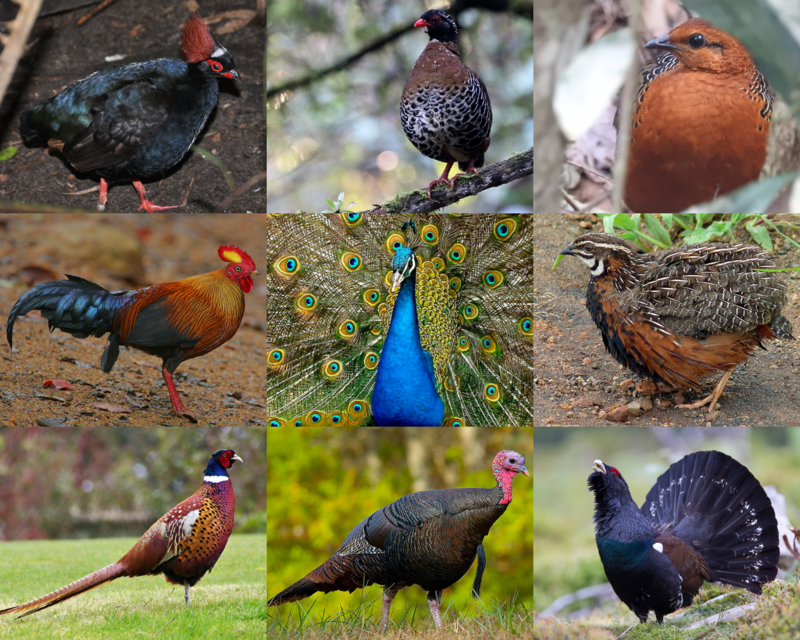
The Phasianidae family of birds is one that contains many popular gamebirds, with a total of 185 species divided across 54 genera.
These heavy ground-living birds include pheasants, partridges, junglefowl, chickens, and turkeys among others like Old World quail and peafowl.
This large family was formerly split into two subfamilies known as the Phasianinae and Perdicinae but this classification has since been changed to reflect more current scientific findings on them.
All these different types of birds have certain things in common such as their strong legs for scratching through leaves or soil looking for food items including insects, seeds, and other vegetation which makes up most of their diet.
They also all tend to be quite colorful in order to attract mates during breeding season when males will often display vibrant feathers or do dances around females in an attempt at courtship ritual displays.
The majority are monogamous creatures too although some may form short-term pair bonds before going off alone again once mating has taken place – either way.
There tends to be very little parental care given by adults after eggs have hatched so chicks need to fend for themselves right away.Scientific classification:
| Kingdom | Animalia |
| Phylum | Chordata |
| Class | Aves |
| Order | Galliformes |
| Superfamily | Phasianoidea |
| Family | Phasianidae Horsfield, 1821 |
Also Featured In: Most Common Birds in China, Common Uzbekistan Birds
2. Sandgrouse
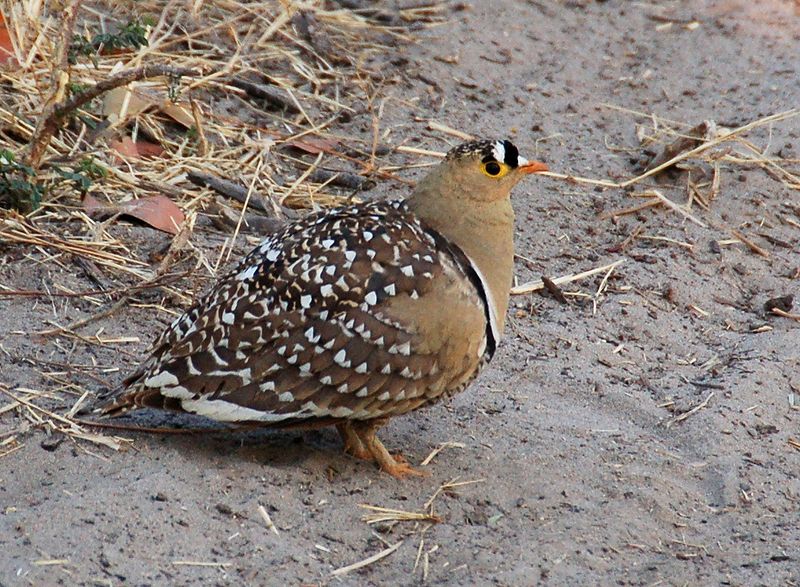
Sandgrouse is birds of the order Pterocliformes, found mainly in Africa and Asia. There are sixteen species belonging to two genera – Syrrhaptes from central Asia and Pterocles from Africa and other Asian countries.
They inhabit treeless areas such as deserts, steppes, scrubland, or savannas and tend to be ground-dwelling birds that feed on seeds.
Sandgrouse has adapted special features for survival in their harsh environment.
They possess well-developed feet with four toes used for walking over hot sand while keeping their body temperature cool at all times by regulating heat loss through their legs.
Their feathers also act like a sponge helping them absorb water before flying long distances back home where they then expel it using specialized glandular secretions located near the wings so that chicks can drink directly from an adult’s breast plumage.Scientific classification:
| Kingdom | Animalia |
| Phylum | Chordata |
| Class | Aves |
| Clade | Columbimorphae |
| Order | Pterocliformes Huxley, 1868 |
| Family | Pteroclidae Bonaparte, 1831 |
Also Featured In: Birds That Live in Iraq, Native Birds of Kazakhstan
3. Plovers

Plovers are a family of around 64-68 species of ground-dwelling birds, commonly found in open country such as fields, meadows and tundras.
They have short bills with webbed feet to help them forage through mud or shallow water.
Plover plumage is usually mottled brown though some species may have brighter colors on the head and wings.
These birds feed mainly on insects but can also eat small crustaceans and worms.
Plovers breed during springtime when they dig holes in sandy or pebbled beaches to lay their eggs which hatch after about 3 weeks incubation period.
They use distraction display behaviour by pretending an injury to the predators away from their nests if needed for protecting their young ones.Scientific classification:
| Kingdom | Animalia |
| Phylum | Chordata |
| Class | Aves |
| Order | Charadriiformes |
| Family | Charadriidae Leach, 1820 |
Also Featured In: Birds of Sweden, Birds Found in Hungary
4. Glareolidae
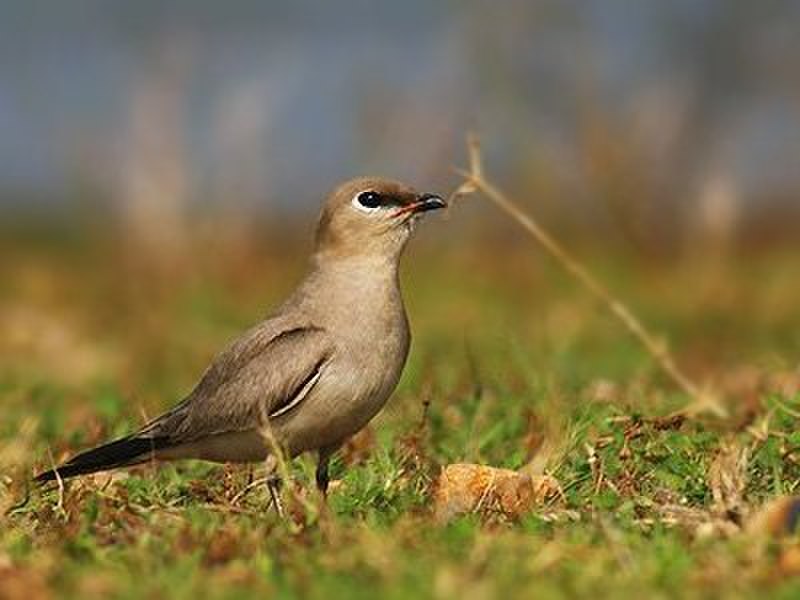
Glareolidae is a family of wading birds, consisting of four genera and 17 species. They are distinguished from other charadrii by their long bills which have a slight downward curve.
Glareolidae live around open grasslands and deserts, where they hunt for insects using the bill to probe into soil or vegetation.
Most species are found in Africa but two pratincoles inhabit parts of Europe and Asia as well.
Coursers tend to be larger than pratincoles with longer legs allowing them to run quickly across sandy dunes while feeding on small animals like lizards or spiders.
Pratincoles feed mainly on flying insects, snatching them out of midair with great agility during flight.
All glareolids share unique features such as large eyes that help it spot prey at night easily making this group one interesting bird family.Scientific classification:
| Kingdom | Animalia |
| Phylum | Chordata |
| Class | Aves |
| Order | Charadriiformes |
| Suborder | Lari |
| Family | Glareolidae CL Brehm, 1831 |
Also Featured In: Belarus Birds You Should Know, Lebanon Birds Live in Semi-Desert Areas
5. Bustard
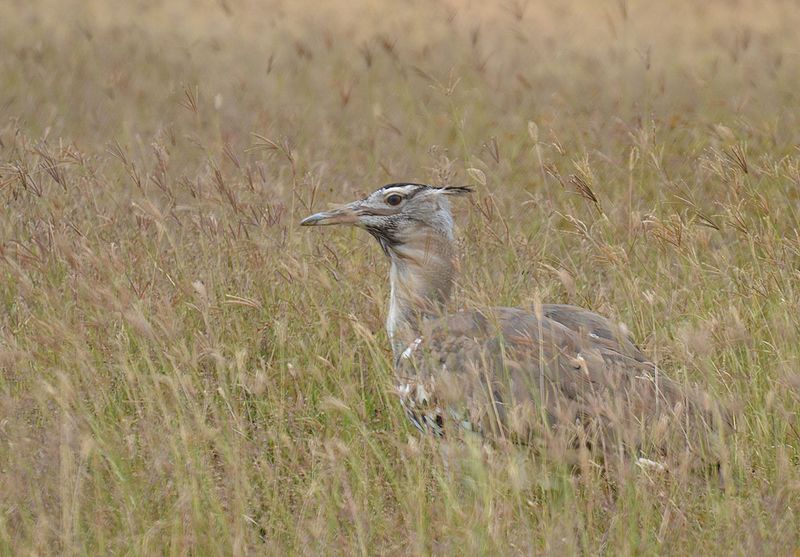
Bustards are large, terrestrial birds that inhabit dry grassland areas and the steppes of the Old World. They range from 40-150 cm in length and belong to the family Otididae.
Bustards have an omnivorous diet consisting of leaves, buds, seeds, fruit as well as small vertebrates and invertebrates.
These birds usually live a solitary life but can be seen gathering around water sources or food during certain times of year such as mating season.
Due to their large size they are vulnerable to predation by foxes or other animals which is why they tend to remain alert at all times.
When in open spaces while relying on camouflage for protection against predators when out in tall vegetation coverings.Scientific classification:
| Kingdom | Animalia |
| Phylum | Chordata |
| Class | Aves |
| Clade | Otidimorphae |
| Order | Otidiformes Wagler, 1830 |
| Family | Otididae Rafinesque, 1815 |
Also Featured In: Common Birds in India, Bulgarian Birds
6. Common Kingfisher
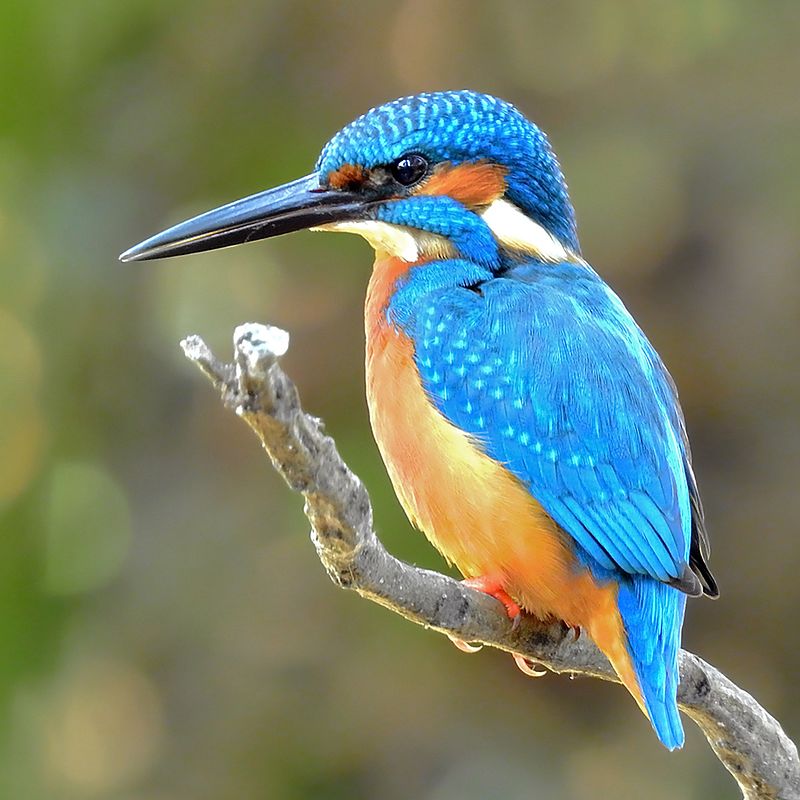
The Common Kingfisher is a small, sparrow-sized bird that can be found across Eurasia and North Africa. It has the typical short tail and large head of kingfishers with seven different subspecies recognized in its range.
They are mainly resident birds but will migrate away during winter when rivers freeze over. The species usually live near bodies of water such as streams or lakes.
Where they hunt for fish by diving from above into the water after spotting their prey below them.
These brightly coloured birds have an unmistakable vibrant blue plumage along with orange underparts and white patches on their wings which makes them easy to recognize amongst other similar looking species.
Their call is loud and shrill making it one of the most recognizable sounds heard around wetlands throughout Europe.Scientific classification:
| Kingdom | Animalia |
| Phylum | Chordata |
| Class | Aves |
| Order | Coraciiformes |
| Family | Alcedinidae |
| Subfamily | Alcedininae |
| Genus | Alcedo |
| Species | A. atthis |
Also Featured In: Common Estonian Birds, Common Birds in the Cities
7. Thrush
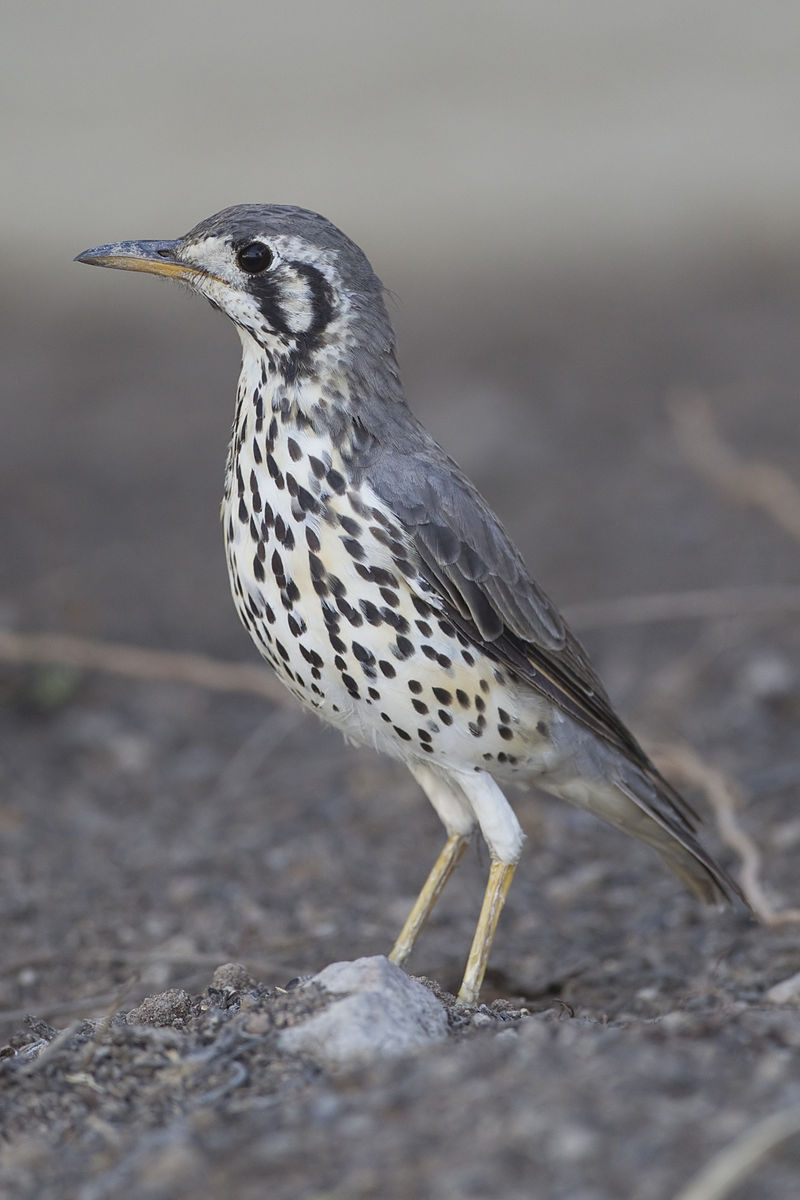
Thrushes are small to medium-sized birds belonging to the Turdidae family, and found all over the world. They live on or near the ground and feed on insects, other invertebrates and fruit.
Their feathers range from greyish browns to deep blues in colour with spotted wings that help them blend into their natural habitats such as forests, woodlands and shrubs.
Thrushes have distinctive songs which they sing during spring mating season; many species also perform complex flight displays for courtship rituals.
These birds may be solitary creatures but can often be seen foraging together in groups or pairs when searching for food sources like worms, snails or berries.
A healthy thrush population is an indication of a balanced environment since they require clean water sources as well as plenty of vegetation cover – making them important indicators of ecosystem health worldwide.Scientific classification:
| Kingdom | Animalia |
| Phylum | Chordata |
| Class | Aves |
| Order | Passeriformes |
| Suborder | Passeri |
| Family | Turdidae Rafinesque, 1815 |
Also Featured In: Common Denmark Birds, Birds that Live in Croatia
8. Shorebirds
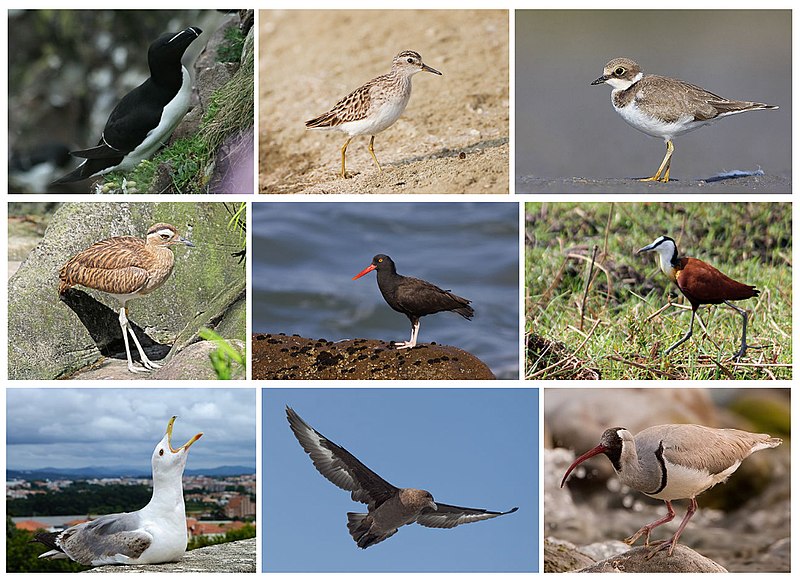
Shorebirds, a diverse group of birds in the Charadriiformes order, are found near water on every continent except Antarctica.
These small to medium-sized birds feed mainly on invertebrates and other small animals but can also be pelagic seabirds or inhabit deserts.
Shorebirds use their long bills to probe mudflats for food like worms and mollusks while some species plunge into the ocean’s depths in search of crustaceans such as crabs and shrimp.
They have strong legs equipped with webbed feet which allow them to move quickly when searching for prey across wetlands, sandbars, beaches and swamps.
Their feathers make them well adapted to life by land or sea due to its hydrophobic nature which helps reduce drag during swimming or flying through windy conditions making it easier for shorebirds survive tough environments around the world.Scientific classification:
| Kingdom | Animalia |
| Phylum | Chordata |
| Class | Aves |
| Infraclass | Neognathae |
| Clade | Neoaves |
| Clade | Gruimorphae |
| Order | Charadriiformes Huxley, 1867 |
Also Featured In: Beautiful Brazilian Birds, Water Birds Live around Us
9. Stone-Curlew

Stone-curlews, also known as dikkops or thick-knees, are a family of birds that have adapted to live in tropical and temperate regions throughout the world.
They can be found in Africa, Asia and Australia with two or more species per region. Despite being classified as waders, most prefer dry arid habitats over moist wetlands.
Stone-curlews typically have long legs which help them navigate through their preferred terrain efficiently; some species even stand at an impressive height when standing on those long legs.
Additionally they feature cryptic plumage which helps them blend into their surroundings while hunting for prey such as insects and small mammals like rodents.
These unique bird’s calls are easily recognizable; it has been said that hearing one is similar to listening to someone whistling ‘Keee Weee’.Scientific classification:
| Kingdom | Animalia |
| Phylum | Chordata |
| Class | Aves |
| Order | Charadriiformes |
| Suborder | Chionidi |
| Family | Burhinidae Mathews, 1912 |
Also Featured In: Birds You’ll Find in Moldova, Armenian Birds You Should Know
10. Bee-Eater

Bee-eaters are one of the most beautiful and vibrant birds in existence. They have a slender body, long wings, down turned bills and their signature elongated central tail feathers which make them instantly recognizable from afar.
Their plumage is incredibly colorful with many shades ranging from blues to greens to reds that glisten when they fly through the air.
These stunning creatures can be found all over Africa, Asia, Southern Europe, Australia and New Guinea where they feed mainly on bees but also other insects like flies or wasps as well as small mammals such as lizards or rodents.
Bee-eaters live in colonies near rivers or wetlands so that they may easily hunt for food while staying close together for safety purposes.
Additionally it allows them to better display their impressive courtship dances during mating season.Scientific classification:
| Kingdom | Animalia |
| Phylum | Chordata |
| Class | Aves |
| Order | Coraciiformes |
| Family | Meropidae Rafinesque, 1815 |
Also Featured In: Common Nigerian Birds, Common Serbian Birds
11. Red-Breasted Goose
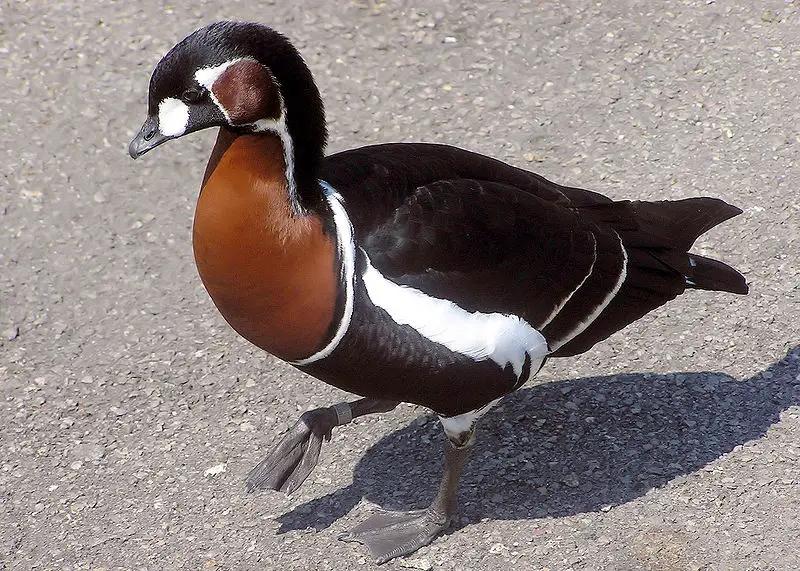
The Red-breasted Goose is a stunning bird that can often be found in Eurasia. It has bright red markings on its chest, neck and head which makes it stand out from other geese species.
The IUCN currently classifies the Red-breasted Goose as vulnerable due to population decline over recent years.
Although some authorities place this goose into its own genus Rufibrenta, most still believe it belongs within Branta bernicla due to similar structure and behaviour of both species.
To help protect this beautiful bird, conservationists are working hard to improve their habitats for breeding so that populations can continue flourishing in future generations.Scientific classification:
| Kingdom | Animalia |
| Phylum | Chordata |
| Class | Aves |
| Order | Anseriformes |
| Family | Anatidae |
| Genus | Branta |
| Species | B. ruficollis |
Also Featured In: Russian Birds, European Birds
12. Eurasian Collared Dove
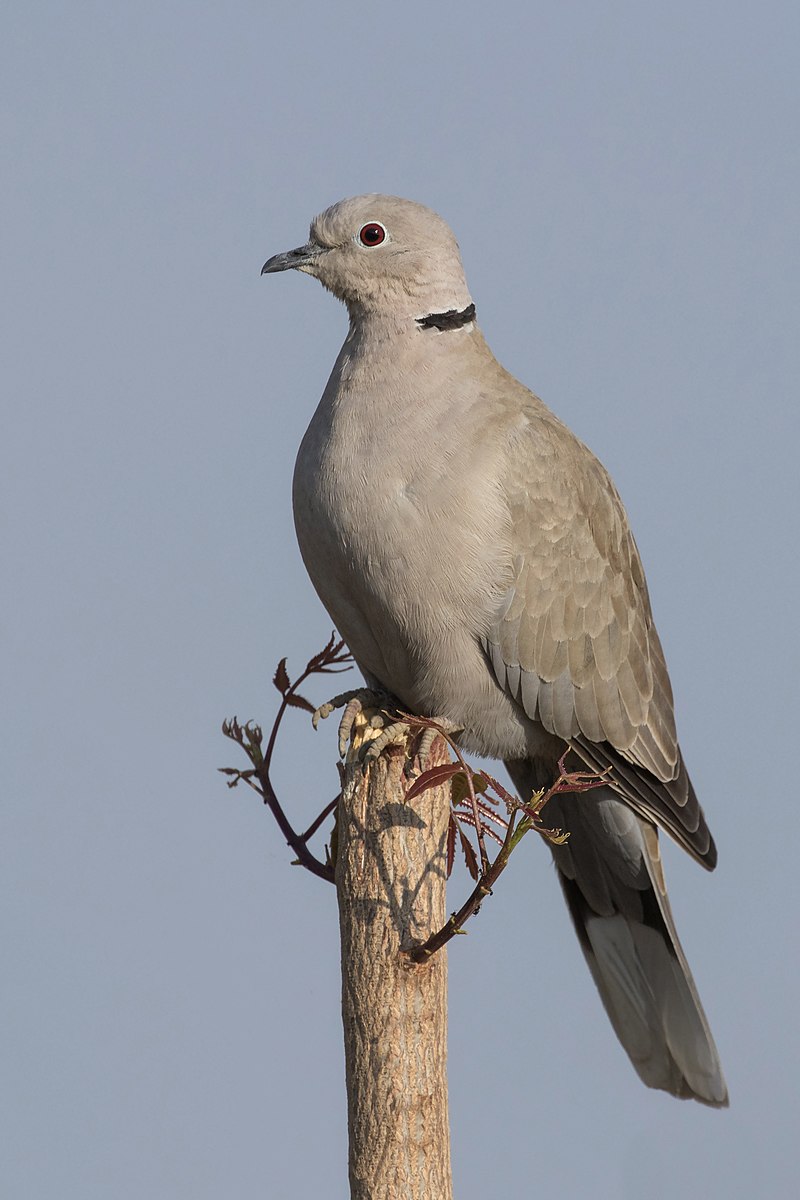
The Eurasian collared dove is a species of bird native to Europe and Asia, with its range expanding through introduction in Japan, North America, and islands in the Caribbean.
It has become so widespread that it is listed as Least Concern on the IUCN Red List. The scientific name for this bird was proposed by Hungarian naturalist Imre Frivaldsz – Columba decaocto.
This beautiful creature typically measures between 33-37 cm from tip to tail feathers, displaying an overall greyish brown plumage; they also have distinctive black half collar around their neck which gives them their common name.
These birds are mainly found inhabiting open woodlands or agricultural lands near human settlements where there’s plenty of food available such as grain fields or gardens where fruits can be eaten off trees.
With a vast global population trend increasing steadily each year these birds make great additions to many backyards throughout the world.Scientific classification:
| Kingdom | Animalia |
| Phylum | Chordata |
| Class | Aves |
| Order | Columbiformes |
| Family | Columbidae |
| Genus | Streptopelia |
| Species | S. decaocto |
Also Featured In: Top Birds Found in Mexico, Birds That Live in Colorado
13. Grey Heron
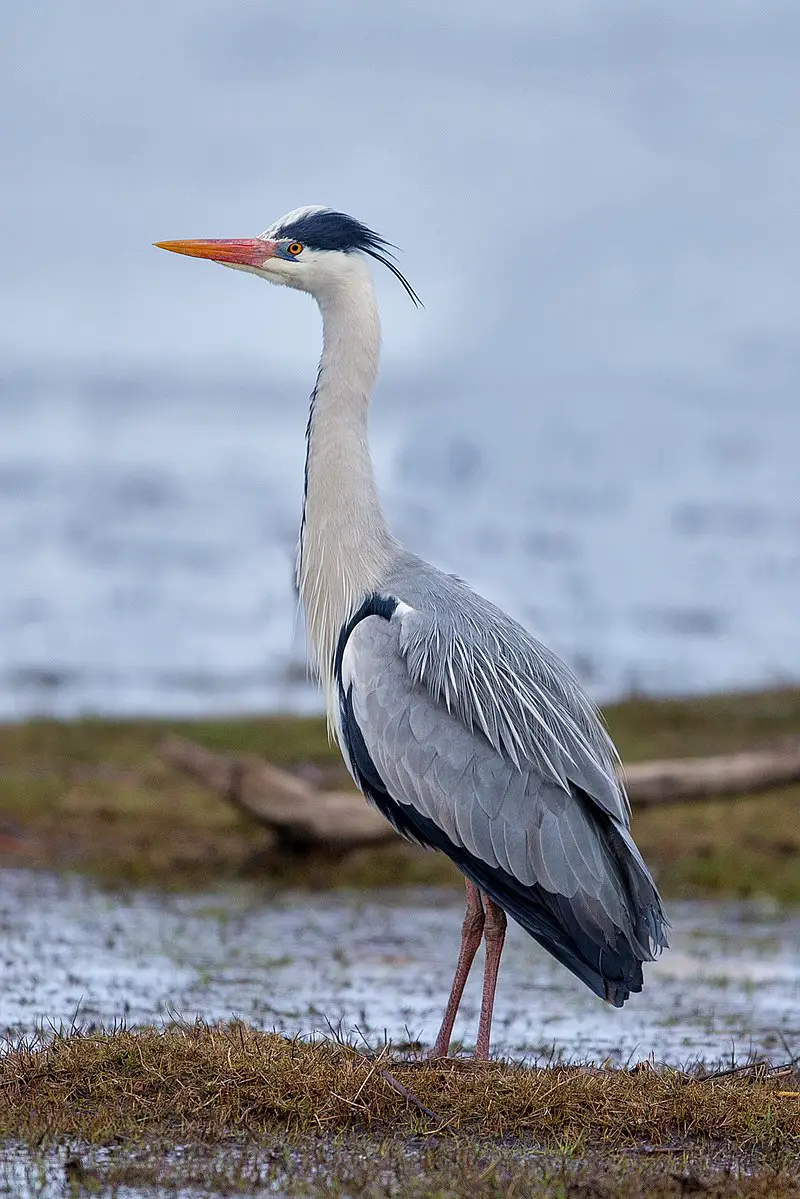
The grey heron is a majestic bird found in temperate regions of Europe, Asia and parts of Africa. It has long legs to wade through the shallow waters where it feeds on aquatic creatures such as frogs, fish and insects.
In wintertime some migrate southwards but others stay put in their natural habitats; lakes, rivers and marshes. They can also be spotted near coasts or along estuaries.
Grey Herons have beautiful blue-grey feathers and an impressive wingspan that makes them stand out from other birds when they soar gracefully across the sky.
These graceful creatures are not only easy on the eye but wise hunters too.Scientific classification:
| Kingdom | Animalia |
| Phylum | Chordata |
| Class | Aves |
| Order | Pelecaniformes |
| Family | Ardeidae |
| Genus | Ardea |
| Species | A. cinerea |
Also Featured In: Common Birds in Japan, Common Slovakian Birds
14. Grebes
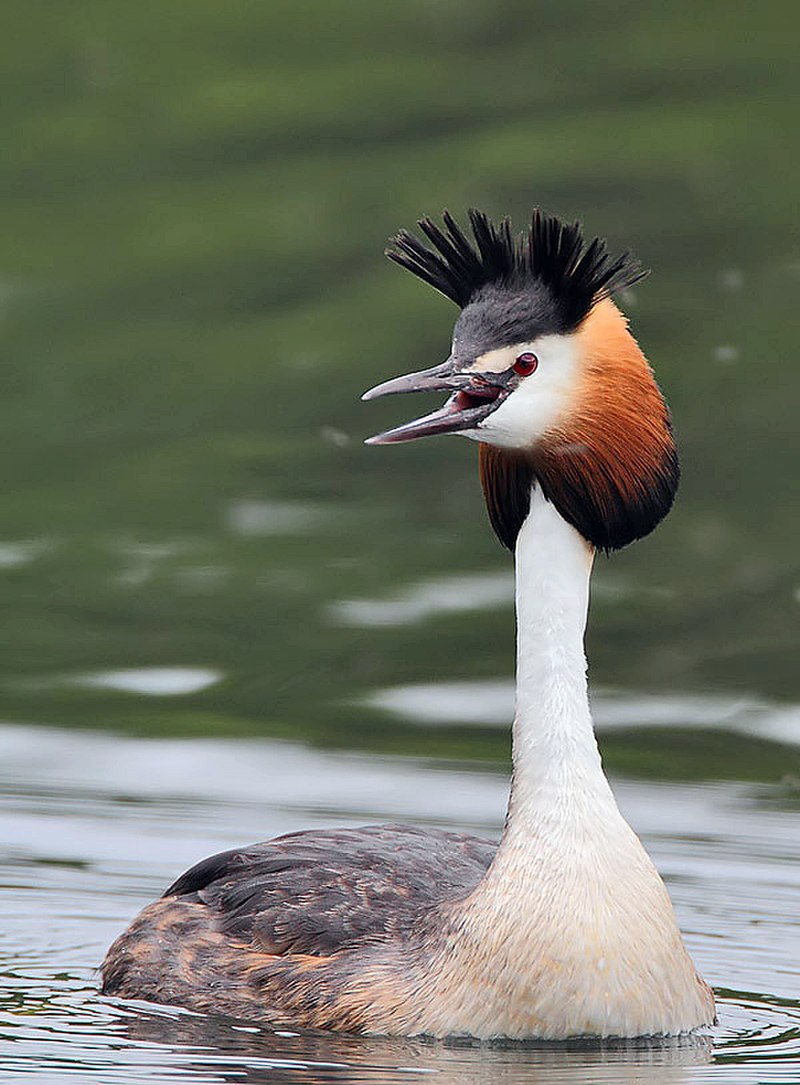
Grebes are a type of diving bird found in freshwater habitats around the world. They belong to the order Podicipediformes and have 22 species that exist across six genera.
Some species can also be found in marine environments during their migration or winter season, and some even live flightless lives on stable lakes.
Grebes vary greatly between regions; for example, they range from 4-32 inches long with anywhere from 8-30 ounces of weight depending on which species it is.
Their plumage may be black, browns/grays or whites but usually consist of bright colors such as yellows, blues and greens while underwater they use these feathers to help them streamline through the water quickly.Scientific classification:
| Kingdom | Animalia |
| Phylum | Chordata |
| Class | Aves |
| Clade | Neoaves |
| Clade | Mirandornithes |
| Order | Podicipediformes Fürbringer, 1888 |
| Family | Podicipedidae Bonaparte, 1831 |
Also Featured In: Birds You’ll Find in Albania, Birds Commonly Found in Slovenia
15. Hoopoes
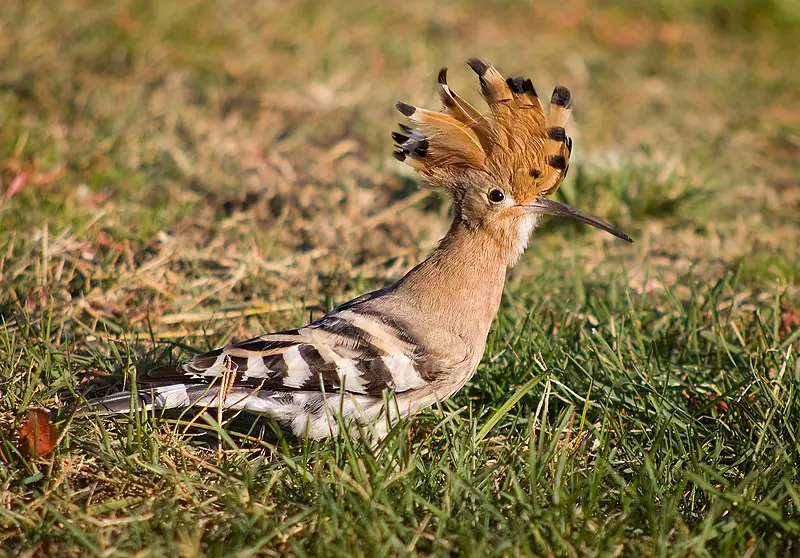
Hoopoes are a fascinating species of bird, found across Africa, Asia and Europe. They have beautiful plumage with unique ‘crowns’ of feathers on their heads.
Three living and one extinct species exist – although for some time they were all classed as the same species: Upupa epops. Some taxonomists still believe this to be true.
These birds are often associated with royalty due to the impressive crown-like crest atop their head, adding an extra element of mystery and exoticism to these creatures.
Hoopoes can also produce loud calls which sound like “hoo-poo” hence why they’ve been given such an apt name.Scientific classification:
| Kingdom | Animalia |
| Phylum | Chordata |
| Class | Aves |
| Order | Bucerotiformes |
| Family | Upupidae Leach, 1820 |
| Genus | Upupa Linnaeus, 1758 |
Also Featured In: Egyptian Birds, African Birds
16. Eurasian Spoonbill
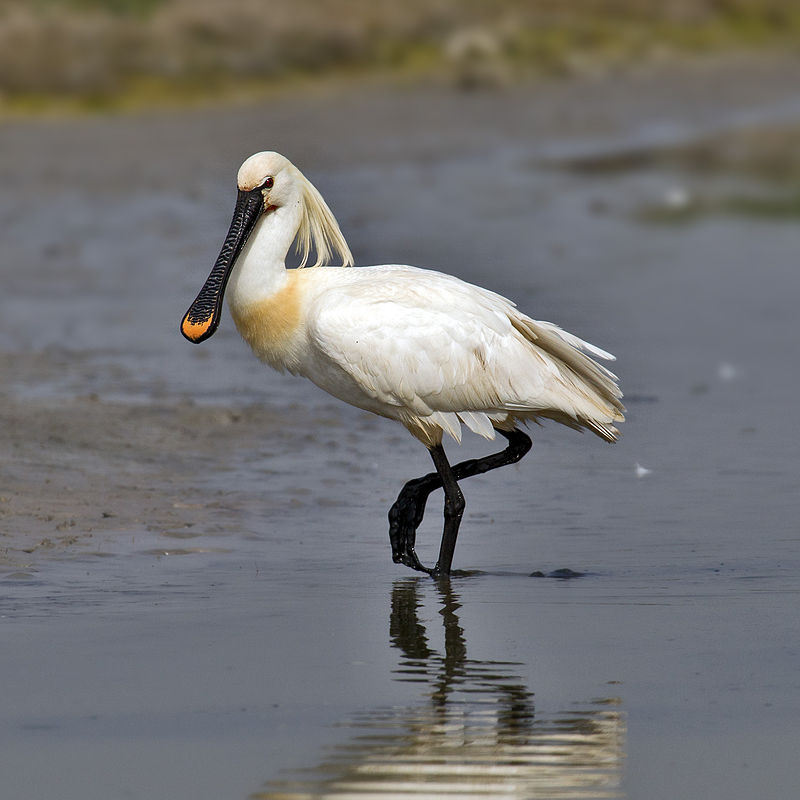
The Eurasian spoonbill is a unique and remarkable wading bird, belonging to the ibis and spoonbill family. It has an unmistakable bill which is broad in shape, giving it its Latin name Platalea “broad”.
Its scientific name ‘leucorodia’ comes from Ancient Greek meaning literally ‘white heron’ due to its predominantly white plumage.
In England this beautiful bird was traditionally known as the ‘shoveler’ because of its distinctive beak.
This rare species can often be found near wetlands or coastal areas where they feed on fish, crustaceans, insects and aquatic invertebrates.
The Eurasian Spoonbill is truly an incredible creature that deserves our protection.Scientific classification:
| Kingdom | Animalia |
| Phylum | Chordata |
| Class | Aves |
| Order | Pelecaniformes |
| Family | Threskiornithidae |
| Genus | Platalea |
| Species | P. leucorodia |
Also Featured In: Common Birds in Tuscany, Common Birds of Portugal
17. European Roller

The European roller is a beautiful bird belonging to the Coracias family, and it’s the only one of its kind found in Europe.
It inhabits various habitats such as dry wooded savanna, bushy plains and other areas except for treeless ones.
During wintertime they usually nest in tree holes, while their range extends into Middle East, Central Asia and Maghreb regions.
They have vibrant blue feathers with black stripes along the neck area which makes them stand out from other birds easily.
Its diet consists mainly of insects like grasshoppers or beetles that are hunted by catching them mid-air during flight; this feature adds an extra charm to these magnificent creatures.Scientific classification:
| Kingdom | Animalia |
| Phylum | Chordata |
| Class | Aves |
| Order | Coraciiformes |
| Family | Coraciidae |
| Genus | Coracias |
| Species | C. garrulus |
Also Featured In: Most Common Lithuanian Birds, Most Common Spain Birds
18. Great White Pelican
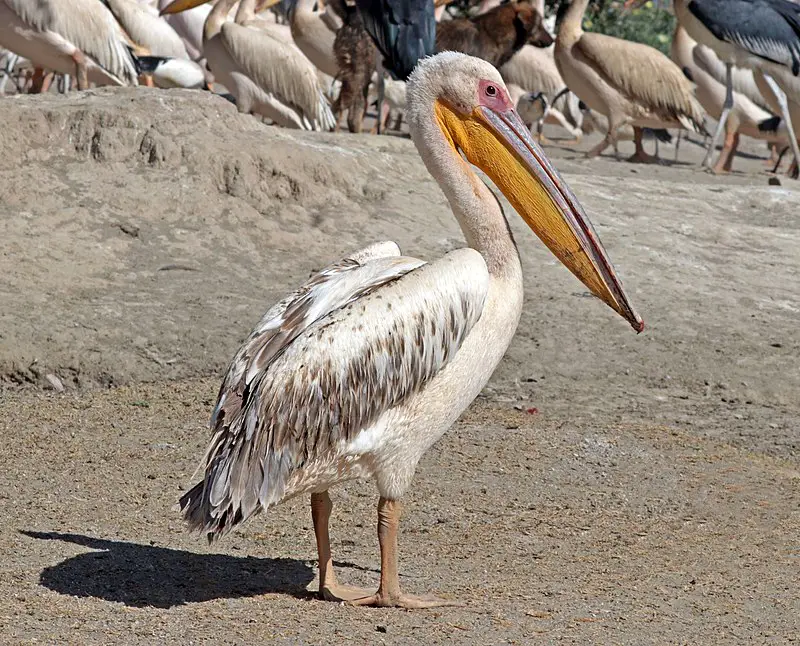
The Great White Pelican is a large bird from the pelican family that breeds in southeastern Europe, Asia and Africa. It inhabits shallow lakes and swamps where it can be seen foraging for food with its long bill.
These majestic birds have white feathers on their body, black wings and tail feathers, along with an orange-colored pouch under their bill.
They are also known to form flocks of up to thousands of individuals when they migrate or gather at breeding sites in search of fish.
The IUCN Red List classifies them as a species of least concern due to stable populations across many regions worldwide.Scientific classification:
| Kingdom | Animalia |
| Phylum | Chordata |
| Class | Aves |
| Order | Pelecaniformes |
| Family | Pelecanidae |
| Genus | Pelecanus |
| Species | P. onocrotalus |
Also Featured In: Large African Birds You Need to Know,
19. Great Spotted Woodpecker
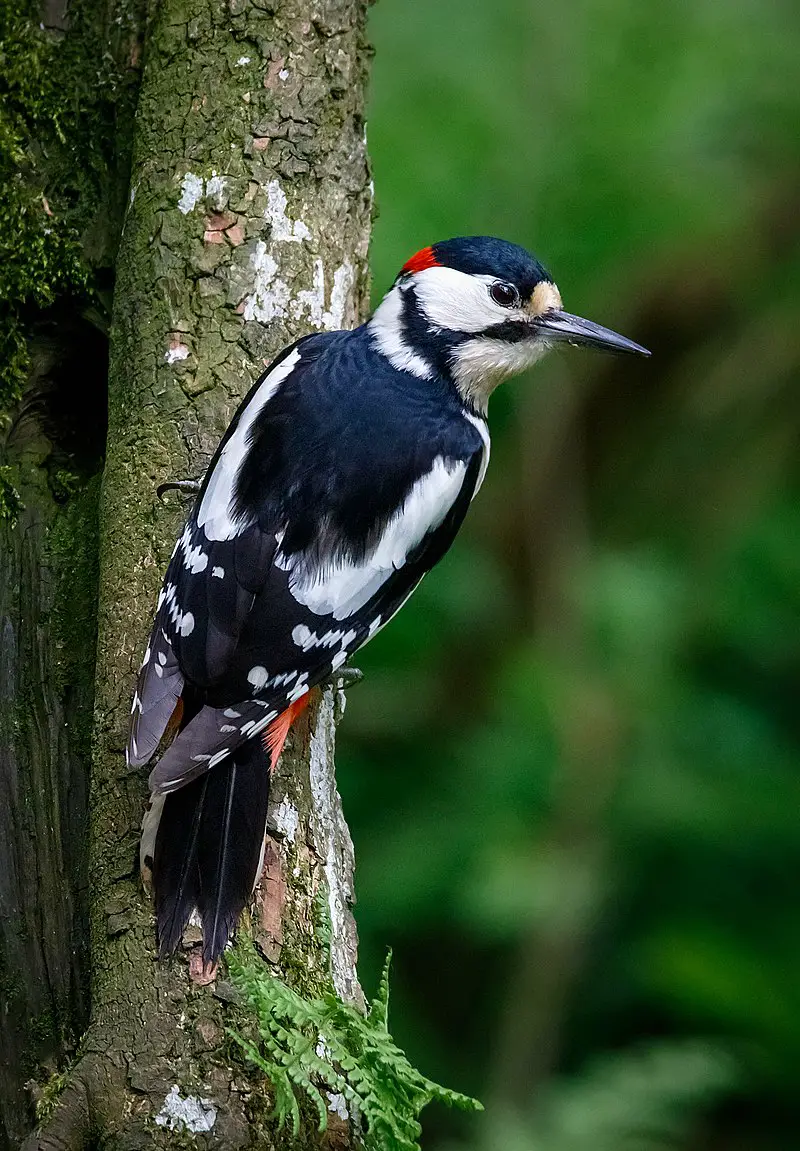
The Great Spotted Woodpecker is a fascinating bird. It has black and white feathers, with red patches on its lower belly and head or neck depending on whether it’s male or young.
This species inhabits most of the Palearctic region as well as some parts of North Africa.
For much of its range, it remains in one place all year round but may migrate if food sources become limited further north.
Its diet consists mainly of insects found under tree bark along with small amounts of seeds and fruit when available.
Despite being quite vocal they are hard to spot due to their camouflaged feathers which helps protect them from predators like cats and birds-of-prey.Scientific classification:
| Kingdom | Animalia |
| Phylum | Chordata |
| Class | Aves |
| Order | Piciformes |
| Family | Picidae |
| Genus | Dendrocopos |
| Species | D. major |
Also Featured In: Native Birds Of Germany, Most Common Nature Birds
20. Little Owl
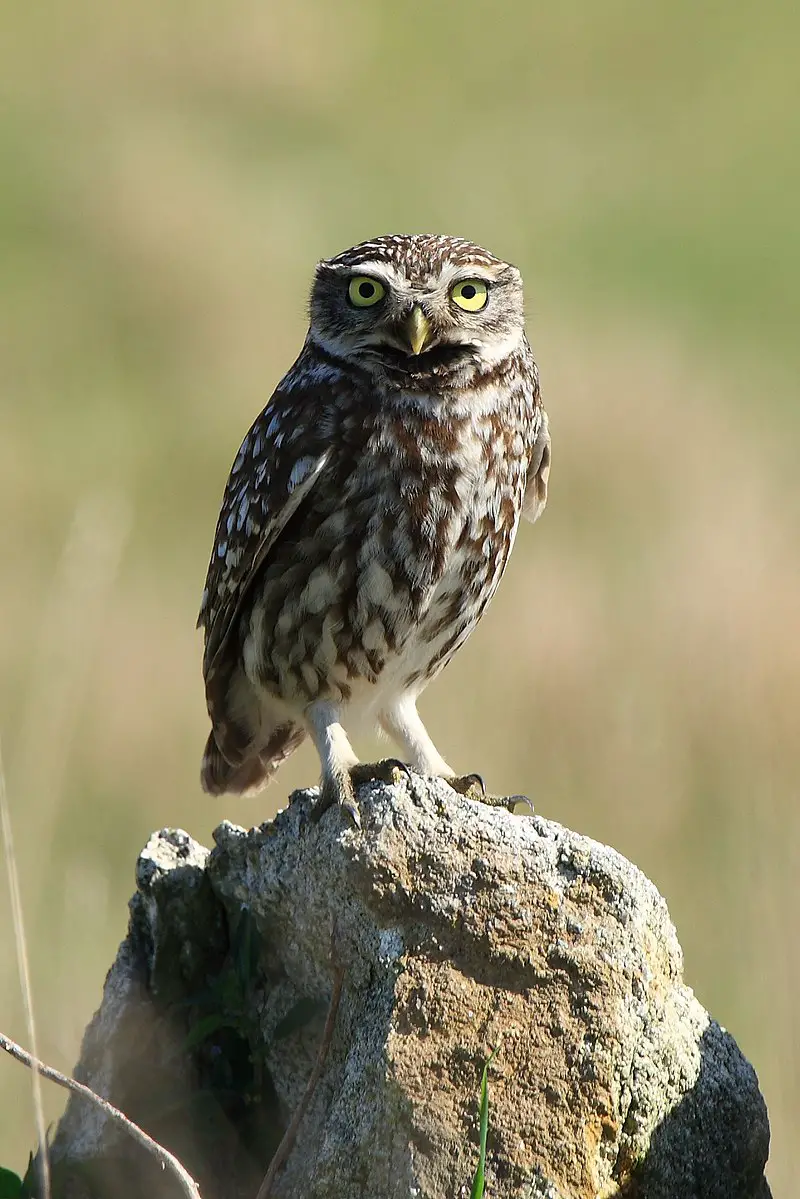
The Little Owl is a fascinating bird that inhabits much of the temperate and warmer parts of Europe, East Asia and North Africa. It’s also known as the “Owl of Athena” or “Owl of Minerva”.
This species was introduced to Britain in late 19th century and New Zealand’s South Island during early 20th century.
They belong to Strigidae family which are true owls with small bodies but large heads along with big eyes that helps them spot prey at night.
These birds feed on insects, earthworms, rodents like mice etc., making them beneficial for controlling pests around agricultural lands.
Besides these benefits they have become an important part in folklore associated with wisdom and knowledge over years due their silent presence near human dwellings after dark hours.Scientific classification:
| Kingdom | Animalia |
| Phylum | Chordata |
| Class | Aves |
| Order | Strigiformes |
| Family | Strigidae |
| Genus | Athene |
| Species | A. noctua |
Also Featured In: Birds of Wales: Exploring Diverse Habitats and Conservation Efforts,
21. Common Swift
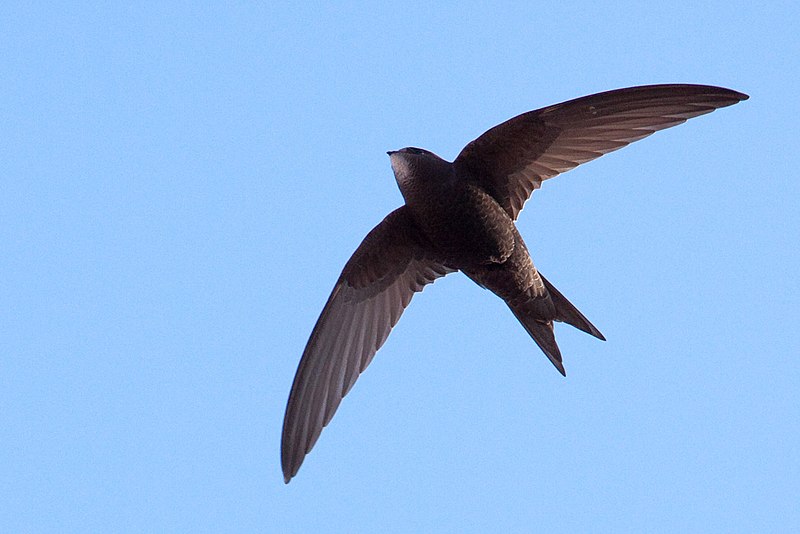
The Common swift is a medium-sized bird with an appearance similar to the barn swallow or house martin.
Its wings are larger, however it is not related to these species but instead belongs in its own order of Apodiformes.
The similarities between the two groups have come about due to convergent evolution and a shared environment.
As for relatives, they can be found among New World hummingbirds and South American swifts; whereas more distant cousins include nightjars as well as treeswifts from Asia/Africa and Australian swiftspecies.
These birds live up high in the air where they remain on constant flight even when sleeping or eating.
They usually migrate south during winter months then return again each springtime bringing life back into our skies.Scientific classification:
| Kingdom | Animalia |
| Phylum | Chordata |
| Class | Aves |
| Order | Apodiformes |
| Family | Apodidae |
| Genus | Apus |
| Species | A. apus |
Also Featured In: Birds of Latvia, Birds that Live in Montenegro
22. Bearded Reedling
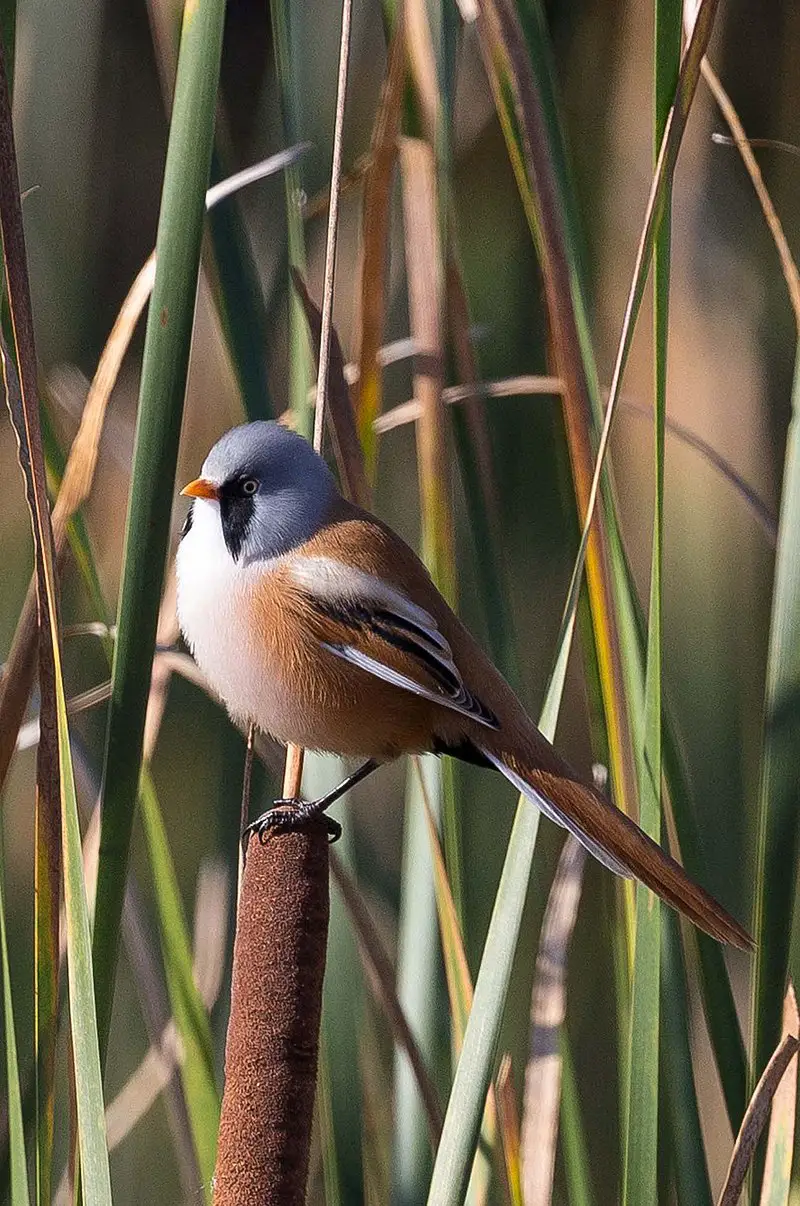
The Bearded Reedling is a small passerine bird found in reed-beds across Europe, Asia and North Africa.
It is easily identified by its distinct black and white plumage with males having yellow faces.
This species belongs to the only family of birds known as Panuridae and was first described by Carl Linnaeus back in 1758.
They feed on insects such as beetles, flies, moths among others but also consume seeds from plants like sedges or rushes during winter months when food availability decreases significantly.
These birds are territorial meaning that they have their own area where they live which can vary from 8 to 12 hectares depending on the seasonality of insect abundance within these areas making them an important part for maintaining healthy ecosystems in wetlands around their range.Scientific classification:
| Kingdom | Animalia |
| Phylum | Chordata |
| Class | Aves |
| Order | Passeriformes |
| Family | Panuridae Des Murs, 1860 |
| Genus | Panurus Koch, 1816 |
| Species | P. biarmicus |
Also Featured In: Birds of United Kingdom,
23. Swallows
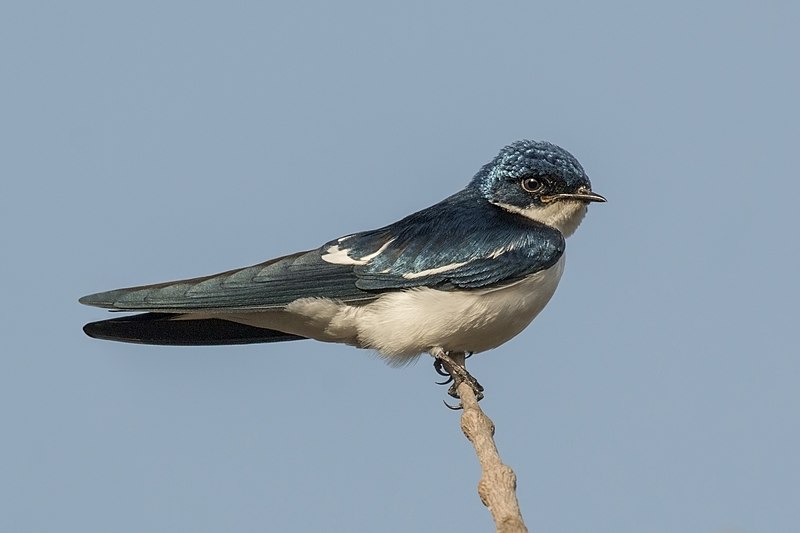
Swallows are small songbirds found around the world on all continents, even Antarctica. They have a distinctive appearance and are highly adapted to aerial feeding with their long wings and forked tail.
There is an estimated 90 species of swallows in 19 different genera, making them one of the most widespread bird families on earth.
The barn swallow is perhaps the most well-known species among these birds due to its presence near human settlements across Europe; they’re so ubiquitous that “swallow” has become synonymous with this particular type of bird there.
Swallows also play important roles in ecology as insectivores; some species migrating vast distances every year between summer breeding grounds and wintering locations.Scientific classification:
| Kingdom | Animalia |
| Phylum | Chordata |
| Class | Aves |
| Order | Passeriformes |
| Suborder | Passeri |
| Family | Hirundinidae Rafinesque, 1815 |
Also Featured In: Birds for Your Home Garden, Flight Birds You Should Know
24. Tit
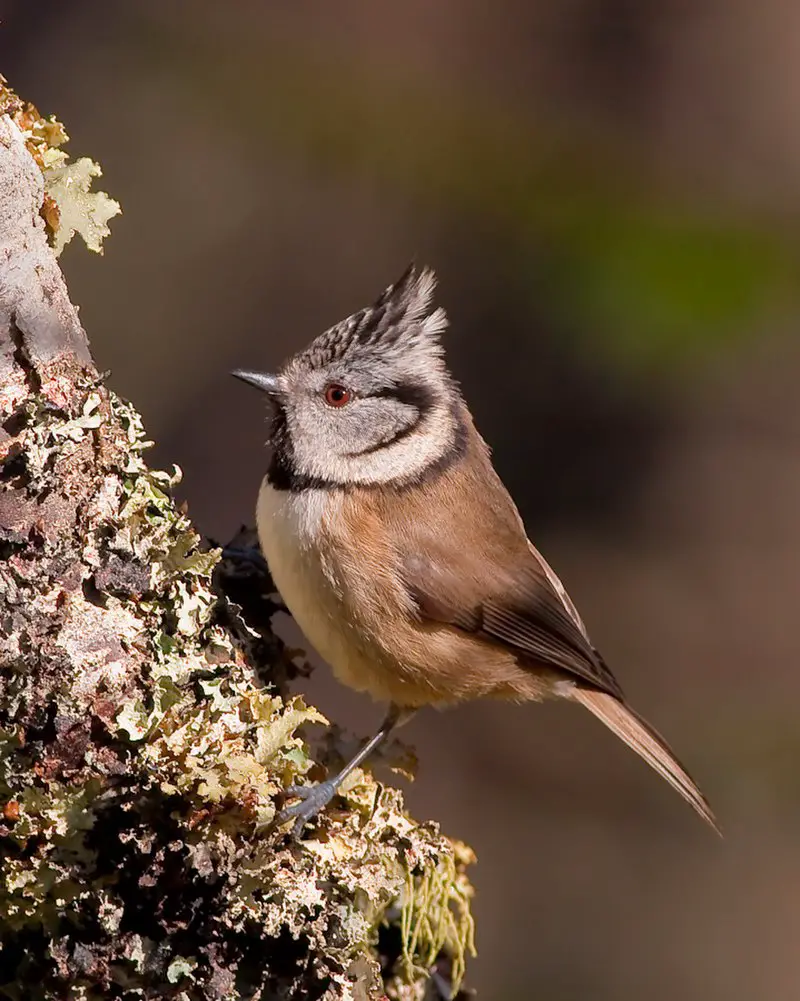
Tit birds are small passerine birds belonging to the family Paridae, found mainly in Northern Hemisphere and Africa.
These active little birds can be seen singing sweet songs throughout the day or scavenging for food at feeders.
They have short, stout bills which they use to crack open seeds and nuts with ease. Tit species range from chickadees to titmice; all of them sport a distinctive black head cap that stands out against their pale grey bodies.
Their bright eyes allow them excellent vision while searching for food – even on gloomy days when other predators may not see as well.
Tits are an important part of any healthy ecosystem and provide many ecological services such as insect control and seed dispersal.Scientific classification:
| Kingdom | Animalia |
| Phylum | Chordata |
| Class | Aves |
| Order | Passeriformes |
| Infraorder | Passerida |
| Family | Paridae Vigors, 1825 |
Also Featured In: Most Common Winter Birds, Willows Birds Around You
25. Eurasian Jay
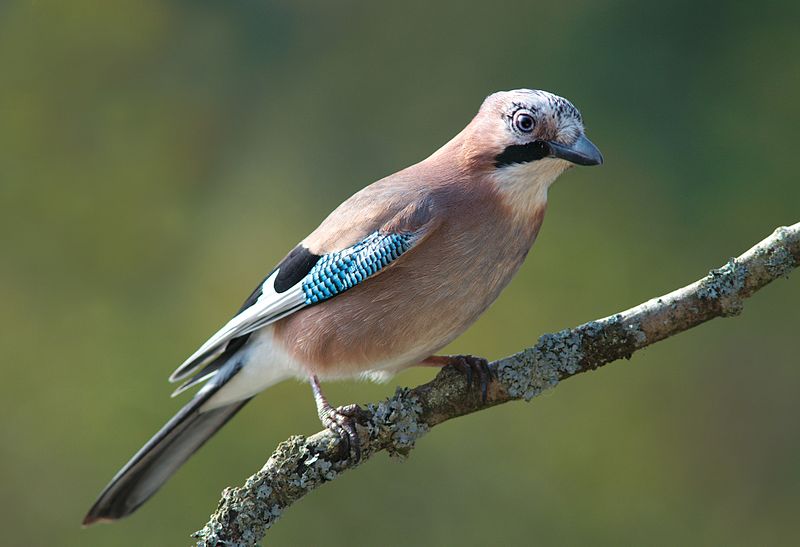
The Eurasian jay is a beautiful passerine bird of the crow family, Corvidae. It has bright pinkish brown plumage with white throat and two black stripes on each side.
The upper wings have an eye-catching blue panel while its tail is all black in color. This species mainly resides in woodlands, spanning over vast regions from western Europe to India and even north-west Africa.
Its diet consists of small invertebrates like insects as well as fruits, seeds and nuts making it quite adaptable when it comes to food sources.
With its loud calls echoing through the forests they inhabit, this amazing creature will definitely make your day brighter if you ever get the chance to spot one.Scientific classification:
| Kingdom | Animalia |
| Phylum | Chordata |
| Class | Aves |
| Order | Passeriformes |
| Family | Corvidae |
| Genus | Garrulus |
| Species | G. glandarius |
26. White-Tailed Eagle
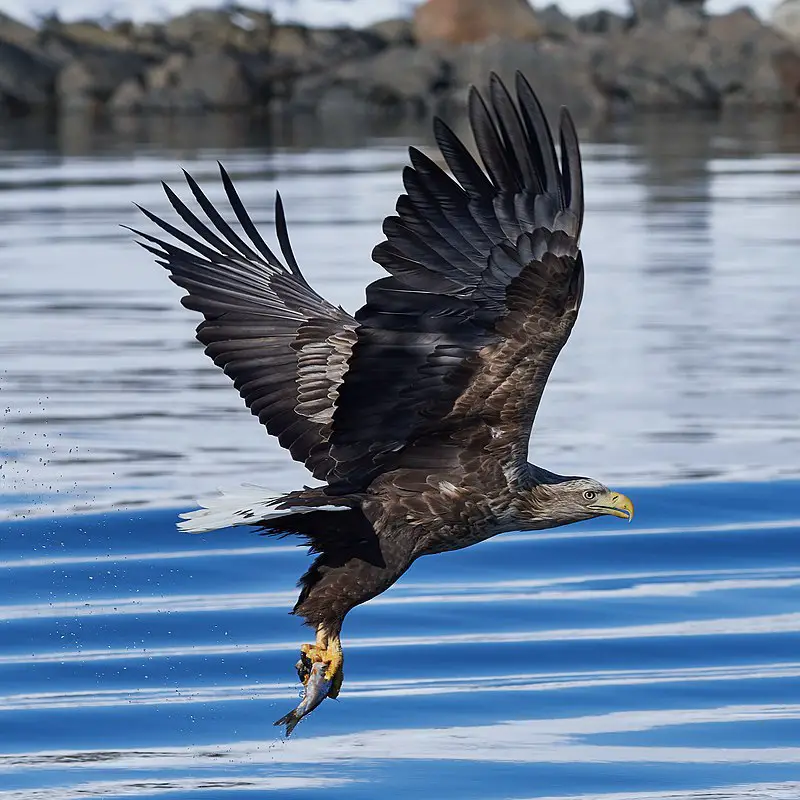
The white-tailed eagle is an impressive species of sea eagle found across temperate Eurasia. This majestic bird belongs to the family Accipitridae, which includes hawks, kites and harriers.
It has a wingspan of up to 2.5 meters and can weigh 4 kilograms or more.
The plumage varies in colour from dark brown above with paler head and neck while its tail is pure white – hence it’s name.
They feed mainly on fish but will also take small mammals, birds and carrion when available.
White-tailed eagles are solitary by nature but form pairs during nesting season typically near bodies of water such as lakes or coasts where they build large stick nests on trees or cliffsides for their young ones to hatch safely in peace.Scientific classification:
| Kingdom | Animalia |
| Phylum | Chordata |
| Class | Aves |
| Order | Accipitriformes |
| Family | Accipitridae |
| Genus | Haliaeetus |
| Species | H. albicilla |
Also Featured In: Most Common Scotland Birds, Birds that Live in Greenland
27. Cormorants
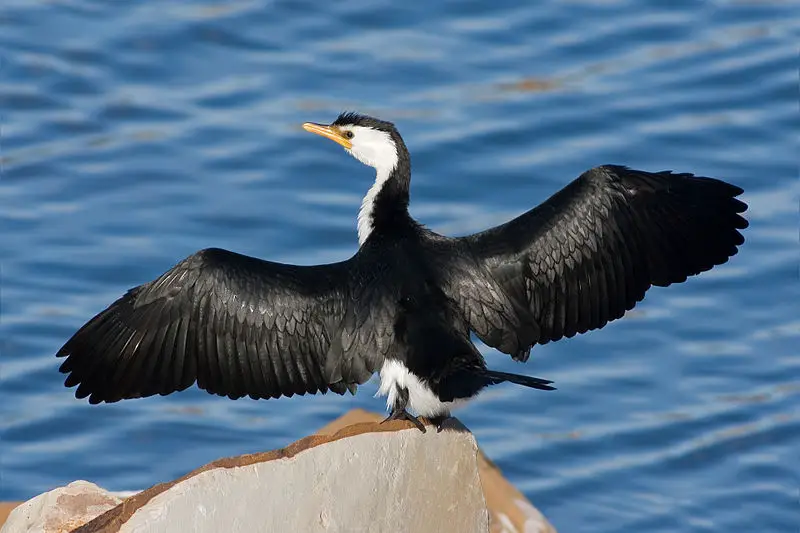
Cormorants are a family of aquatic birds found around the world. They include 40 species, such as great cormorants and common shags.
In Britain, these two species are the most commonly seen in their natural habitats.
Cormorants have long necks, webbed feet and can be identified by their glossy black feathers which they use to help them swim through water with ease as they hunt for food like fish or crustaceans.
They have an impressive wingspan often reaching up to five feet across when fully extended.
Despite being strong swimmers, these birds also enjoy spending time perched on rocks near rivers or shorelines where they will preen themselves in order to keep clean and dry during cooler weather conditionsScientific classification:
| Kingdom | Animalia |
| Phylum | Chordata |
| Class | Aves |
| Order | Suliformes |
| Family | Phalacrocoracidae Reichenbach, 1850 |
Also Featured In: Most common Birds in France, Birds You’ll Find in the Sea
28. Great Egret

The Great Egret is a large, white bird found in many regions of the world. It has four subspecies that reside across Asia, Africa, Americas and southern Europe.
This species usually lives near bodies of water such as lakes and marshes. They are also now starting to spread into more northern areas of Europe due to climate change.
These birds have long yellow legs with an impressive wingspan for their size which allows them to soar majestically through the sky hunting for fish or amphibians in shallow waters below.
Their feathers have been used historically by Native Americans as part of traditional garments or ceremonies but this practice should be avoided today so these amazing creatures can thrive without harm from humans.Scientific classification:
| Kingdom | Animalia |
| Phylum | Chordata |
| Class | Aves |
| Order | Pelecaniformes |
| Family | Ardeidae |
| Genus | Ardea |
| Species | A. alba |
Also Featured In: Birds Live in Arkansas, Swamps Birds You Should Know
29. Rail
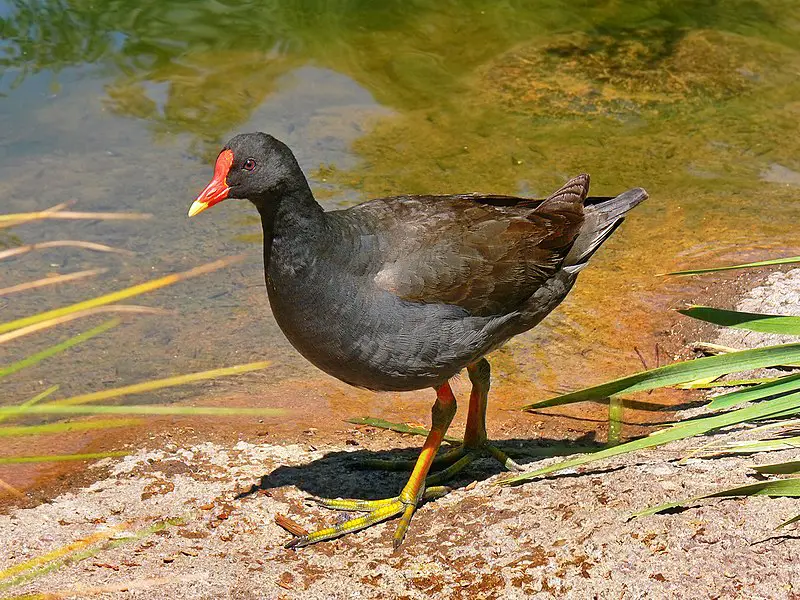
Rails are a diverse family of birds, ranging from small to medium size and living in habitats across the world.
They can be found around wetlands, as well as any other land-based environment except for dry deserts, polar regions or areas with persistent snow cover.
These ground-dwellers have short legs and long toes that help them maneuver through wetland vegetation easily.
Tey typically feed on insects and aquatic invertebrates but will also eat seeds and berries when available.
Species such as coots, crakes and gallinules have evolved different bill shapes to allow them to navigate their environments more efficiently while searching for food.
Rails live both alone or in pairs depending on the species; some migrate seasonally while others remain at one location year round.Scientific classification:
| Kingdom | Animalia |
| Phylum | Chordata |
| Class | Aves |
| Order | Gruiformes |
| Family | Rallidae Rafinesque, 1815 |
Also Featured In: Wetlands Birds You Should Know, Birds that Live in Tamil Nadu
30. Procellariidae
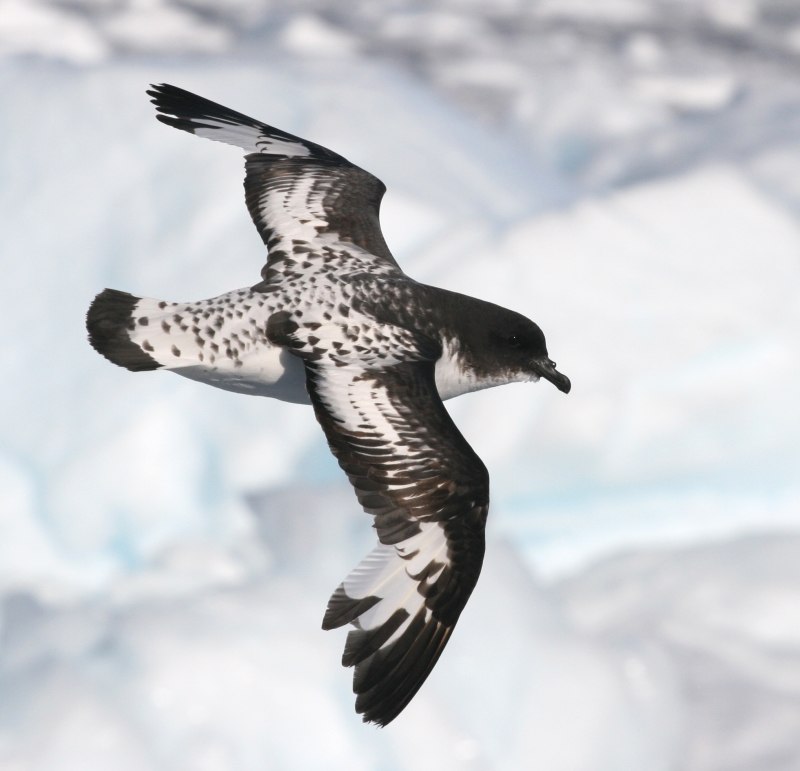
Procellariidae is a diverse family of seabirds belonging to the bird order Procellariiformes.
These birds are commonly referred to as tubenoses and include fulmarine petrels, gadfly petrels, diving petrels, prions, and shearwaters.
They range in size from the small storm-petrel which measures around 18cm long to the giant albatross which can reach up to 3 meters in length.
Generally found near oceans or coasts where they feed on fish as well as squid and other marine life depending on species.
Many procellariids will also nest inland during breeding season before returning back out at sea for most of their lives.
Their wings have specially adapted feathers that give them incredible gliding abilities allowing them literally fly with minimal effort over vast distances across oceanic regionsScientific classification:
| Kingdom | Animalia |
| Phylum | Chordata |
| Class | Aves |
| Order | Procellariiformes |
| Family | Procellariidae Leach, 1820 |
Also Featured In: Common Republic of Nauru Birds, Birds that Live in the Ocean
31. Threskiornithidae
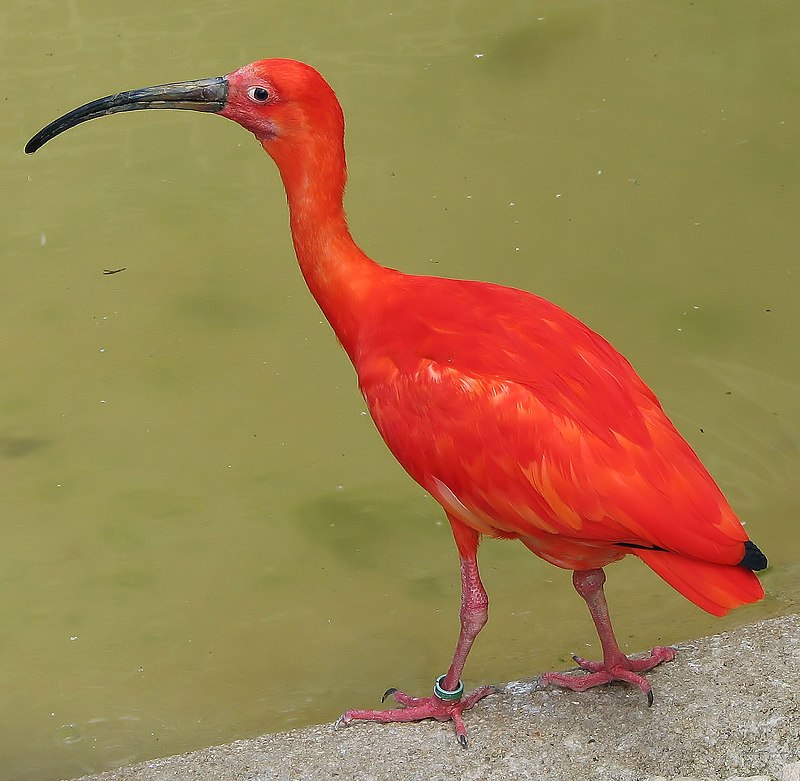
Threskiornithidae is a family of large wading birds which includes 36 species. These birds are traditionally divided into two subfamilies – the ibises and the spoonbills.
However, recent genetic analysis has shown that spoonbills actually belong to Old World ibis group, while New World ibises form an early offshoot from this lineage.
Threskiornithidse members have long curved beaks with serrated edges used for catching fish in shallow water or mudflats, as well as other aquatic invertebrates like crustaceans and mollusks.
They also feed on plant matter such as grains and seeds found close to wetlands areas where they live.
This diverse diet makes them important scavengers in their ecosystems, helping maintain healthy populations of native wildlife by controlling insect numbers and dispersing energy-rich seeds throughout wetland habitats.Scientific classification:
| Kingdom | Animalia |
| Phylum | Chordata |
| Class | Aves |
| Order | Pelecaniformes |
| Suborder | Ardei |
| Family | Threskiornithidae Richmond, 1917 |
Also Featured In: Birds Commonly Found in Northern Ireland, Birds that Live in Faroe Islands
32. Mute Swan
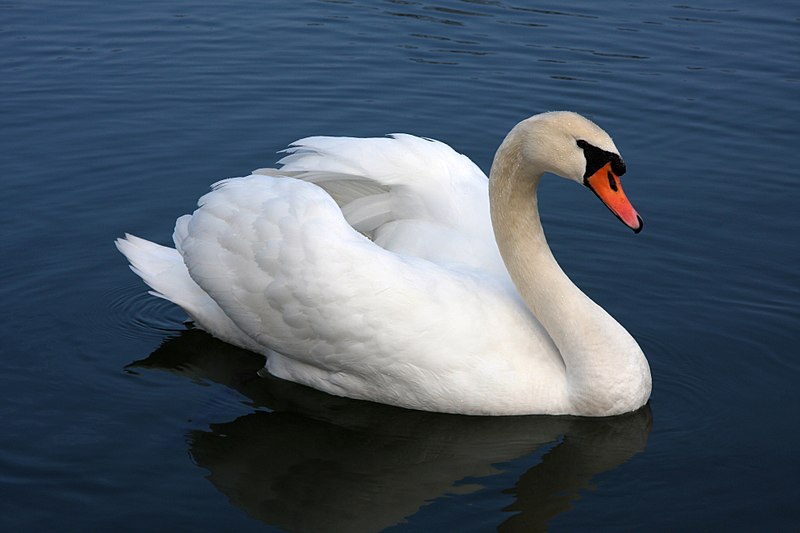
The Mute Swan is a species of swan belonging to the waterfowl family Anatidae. It can be found in much of Eurosiberia, as well as North America, Australasia and southern Africa where it has been introduced.
The ‘mute’ part of its name comes from its soft call which is more muffled than that of other swans.
They have an almost entirely white plumage with black legs and feet and an orange bill with a distinctive knob at the base.
These striking birds are large in size reaching up to 1 metre tall when fully grown with wingspans reaching 3 metres or more.
In flight they hold their necks arched gracefully above their body while beating powerful wings slowly through the air – creating quite a spectacle.Scientific classification:
| Kingdom | Animalia |
| Phylum | Chordata |
| Class | Aves |
| Order | Anseriformes |
| Family | Anatidae |
| Genus | Cygnus |
| Species | C. olor |
Also Featured In: Tundra Birds, Large Birds of Michigan
33. Great Bustard
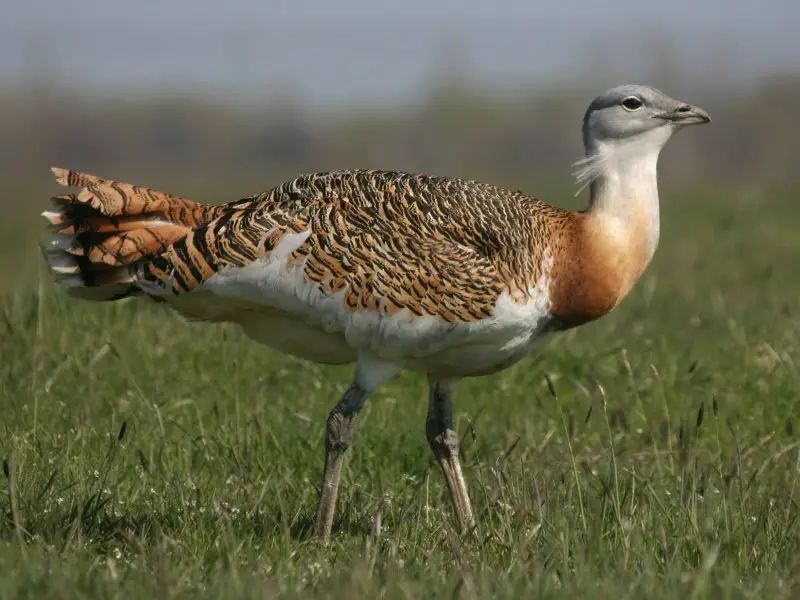
The Great Bustard is a large bird found in open grasslands and farmland across Europe, Central Asia and northern Morocco.
It has a distinctive appearance – its feathers are grey-brown with white below the neck while its head is dark brown.
The species was listed as Vulnerable on the IUCN Red List in 1996 due to population declines caused by habitat loss, overhunting and illegal trade of eggs or chicks.
Conservation efforts provide hope for this majestic creature’s future – some European countries have reintroduced them back into their native habitats through captive breeding programs.
There’s no doubt that we must protect these beautiful birds if they’re to continue soaring majestically above our landscapes for years to come.Scientific classification:
| Kingdom | Animalia |
| Phylum | Chordata |
| Class | Aves |
| Order | Otidiformes |
| Family | Otididae |
| Genus | Otis |
| Species | O. tarda |
Also Featured In: Native South Korean Birds,
34. Falcons And Caracaras
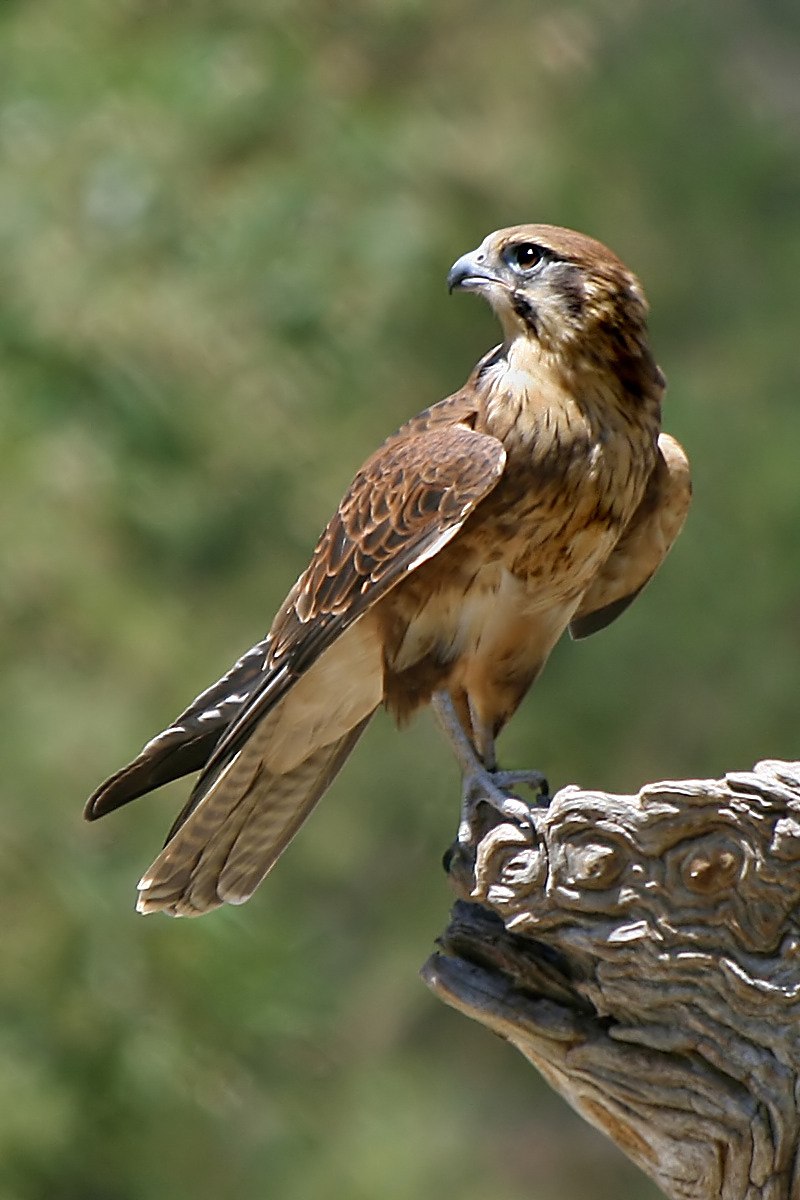
Falcons and caracaras are birds of prey that belong to the family Falconidae. They have impressive sharp talons, hooked beaks and keen eyesight which makes them excellent hunters.
Falcons can reach speeds up to 200 mph when diving for their prey while caracaras use a combination of running and flying to hunt small mammals such as rabbits or rats.
Both falcons and caracaras live in various areas around the world from grasslands, deserts, forests, wetlands or even urban areas where they nest on cliffs or tall buildings.
The diet mainly consists insects but also includes larger animals like reptiles or other birds which they catch by surprise with fast dives out of the sky.Scientific classification:
| Kingdom | Animalia |
| Phylum | Chordata |
| Class | Aves |
| Order | Falconiformes |
| Family | Falconidae Leach, 1820 |
Also Featured In: Most Common Taiwan Birds, Queensland Birds You Should Know
35. European Bee-Eater
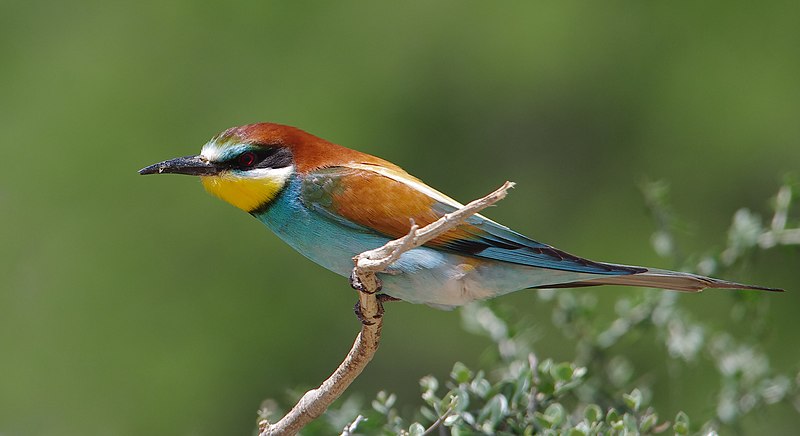
The European Bee-Eater is a stunningly beautiful bird, boasting an array of bright colors. Its head and neck are light blue with greenish ear coverts and its back is chestnut brown.
The wings have yellow primaries bordered in black, while the rest of the feathers contain hues of pink, russet orange, grayish-blue and olive green.
This species can be found breeding throughout Southern Europe to Central Asia as well as Northern Africa to South Africa where it likes to inhabit open country near rivers or streams with bare banks for nesting purposes.
It migrates during winter months down into tropical areas within both Africa and India but will occasionally overshoot northwards which may result in rare sightings elsewhere on occasion too.Scientific classification:
| Kingdom | Animalia |
| Phylum | Chordata |
| Class | Aves |
| Order | Coraciiformes |
| Family | Meropidae |
| Genus | Merops |
| Species | M. apiaster |
Also Featured In: Birds of Poland, Most Common Birds of Corsica
36. Ural Owl
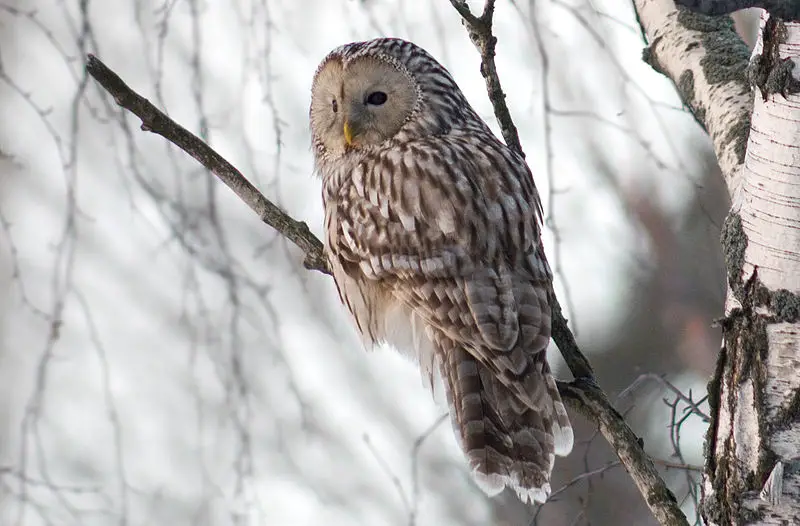
The Ural owl is a majestic nocturnal bird of the Strigidae family. It has an impressive wingspan, usually between 28 to 38 inches wide.
This species can be seen throughout much of Eurasia, from northern Scandinavia and Scotland all the way east across Russia into Korea and Japan; it even reaches southern parts of Mongolia.
The Ural owl sports brown feathers with white spots that help it blend in with its environment during the day making it difficult for predators or humans alike to spot them easily.
These owls also have large yellow eyes which helps them hunt better at night by being able to see their prey more clearly in dim light conditions.
All these features combined make the Ural owl one truly remarkable creature.Scientific classification:
| Kingdom | Animalia |
| Phylum | Chordata |
| Class | Aves |
| Order | Strigiformes |
| Family | Strigidae |
| Genus | Strix |
| Species | S. uralensis |
Also Featured In: Birds You’ll Find in Hokkaido,
37. Skuas
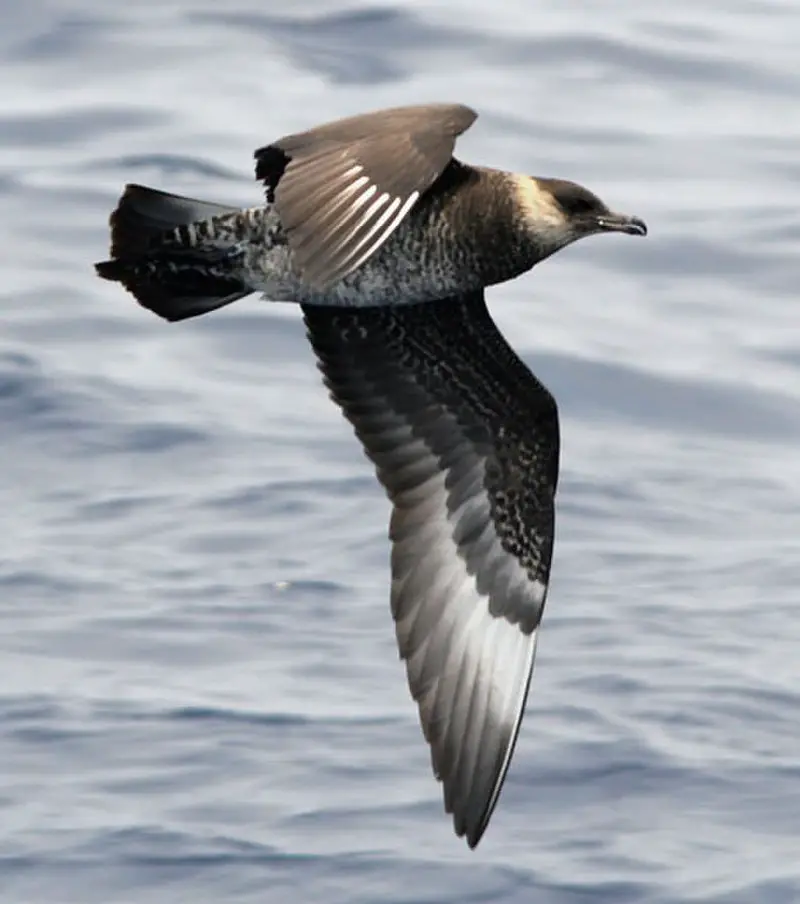
Skuas are a group of predatory seabirds with seven species, all belonging to the genus Stercorarius.
They are also known as “Jaegers” in North America and their name originates from the Faroese word for Great Skua – skúgvur.
These birds typically inhabit coastal areas or open oceans where they feed on fish, krill and other marine creatures.
Skuas can be distinguished by their pointed wings which help them fly long distances while hunting food.
Their distinctive colouration varies depending on age and habitat but generally includes greyish brown upperparts and white underparts with black streaks along its belly area.
The overall size ranges from 24-40 cm making these one of the larger sea bird species.Scientific classification:
| Kingdom | Animalia |
| Phylum | Chordata |
| Class | Aves |
| Order | Charadriiformes |
| Suborder | Lari |
| Family | Stercorariidae Gray, 1871 |
| Genus | Stercorarius Brisson, 1760 |
Also Featured In: Birds of Morocco, Common United Arab Emirates Small Birds
38. Pelican
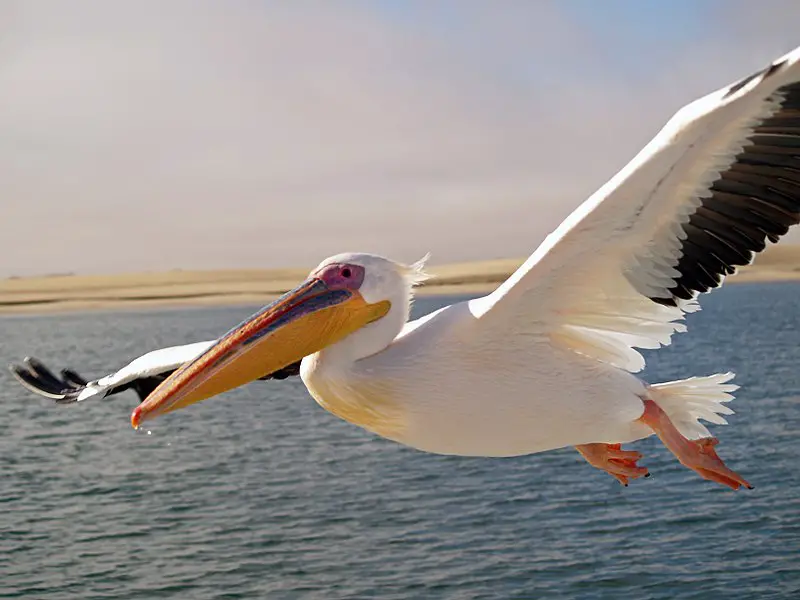
Pelicans are a large water bird and form part of the family Pelecanidae. They have long beaks, allowing them to scoop up prey from both land and sea with ease.
Their most distinctive feature is their huge throat pouch which they use to drain water before swallowing their food.
Most pelican species have predominantly pale plumage however exceptions such as the brown and Peruvian pelicans exhibit darker colouring.
The bill, face skin and pouch of all Pelican species become brightly coloured during breeding season in order to attract mates.
Pelicans can often live up to 25 years due to the fact that they eat mostly fish which provides them with enough nutrients for longevity.Scientific classification:
| Kingdom | Animalia |
| Phylum | Chordata |
| Class | Aves |
| Order | Pelecaniformes |
| Family | Pelecanidae |
| Genus | Pelecanus Linnaeus, 1758 |
Also Featured In: Most common birds in Australia, Famous Paintings Birds
39. Eurasian Golden Oriole
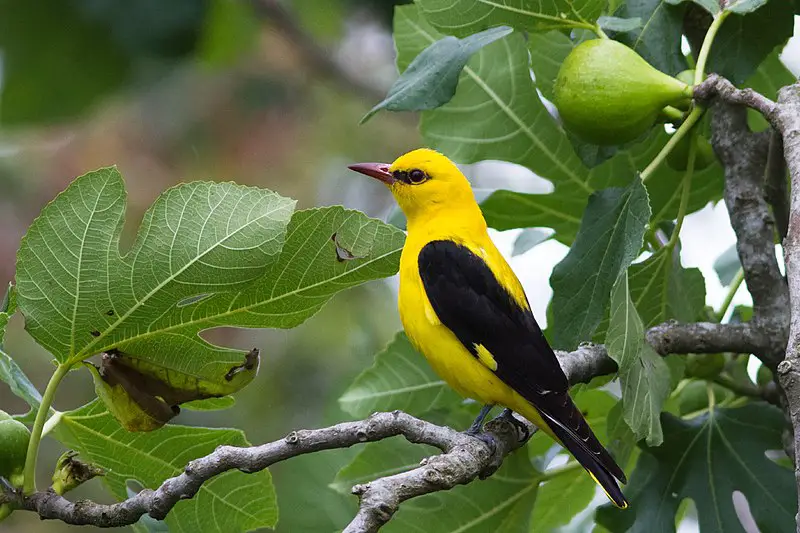
The Eurasian golden oriole is a beautiful bird belonging to the Old World oriole family of passerine birds that breed in temperate climates of the Northern Hemisphere.
It migrates from Europe and Palearctic during summer season, and spends its winter months in central and southern Africa.
These birds have an impressive range with large populations which appear to be stable or increasing across much of their range due to conservation efforts.
They are mostly found near forests, woodlands, riverbanks and meadows where they feed on fruits as well as insects such as caterpillars, beetles, grasshoppers etc.
The males can easily be identified by their bright yellow plumage while females are more olive coloured.
All in all these stunningly colourful creatures add vibrancy to our environment.Scientific classification:
| Kingdom | Animalia |
| Phylum | Chordata |
| Class | Aves |
| Order | Passeriformes |
| Family | Oriolidae |
| Genus | Oriolus |
| Species | O. oriolus |
Also Featured In: Most Beautiful birds of Greece, Birds That Live in the Jungle
40. Dalmatian Pelican
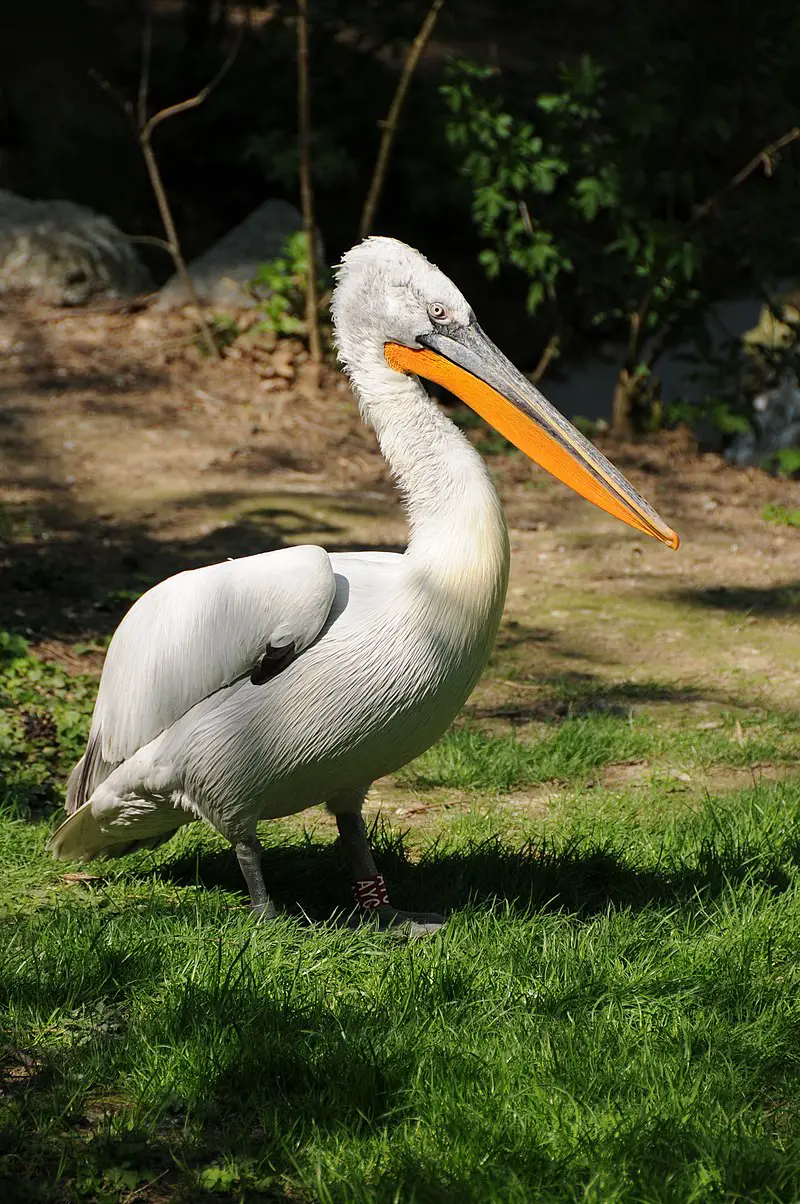
The Dalmatian pelican is an impressive bird, the largest of its family and one of the largest freshwater birds in the world.
Its wingspan rivals even those of albatrosses and it flies gracefully with other members in synchrony.
It has a wide range across Central Eurasia stretching from Mediterranean to India and Southeast Asia, as well as parts of Russia.
This large species has white feathers which are generally lightly tinged with grey or yellow around their head; they have long beaks that can reach up to 40cm in length.
Their unique physical characteristics make them stand out among other waterbirds – so if you ever get lucky enough to spot one while exploring nature, take some time to appreciate this majestic creature.Scientific classification:
| Kingdom | Animalia |
| Phylum | Chordata |
| Class | Aves |
| Order | Pelecaniformes |
| Family | Pelecanidae |
| Genus | Pelecanus |
| Species | P. crispus |
Also Featured In: Hong Kong Birds You Need to See, Urban Birds of Hong Kong
41. Short-Toed Snake Eagle
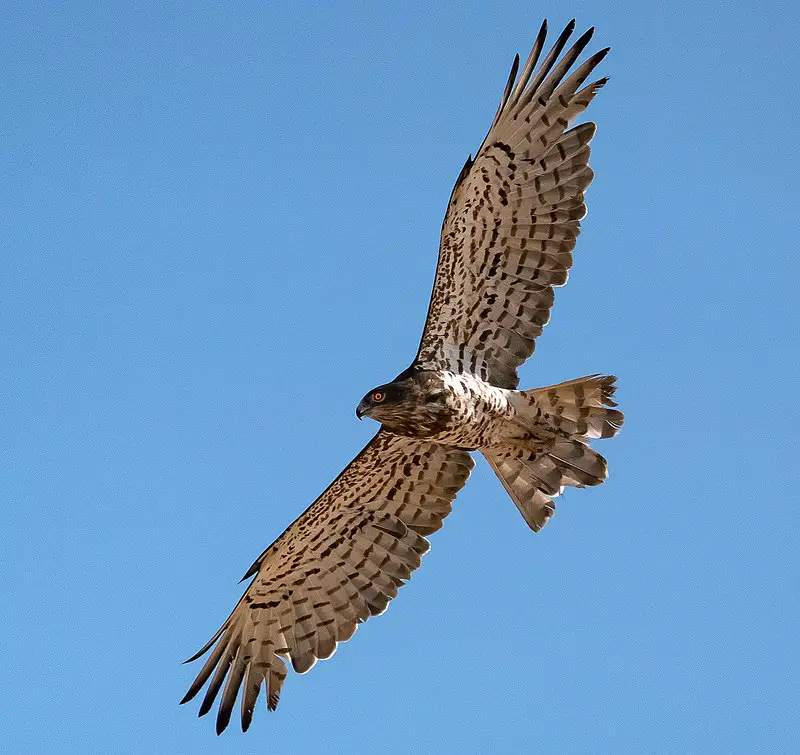
The Short-toed Snake Eagle is a medium sized bird of prey that belongs to the Accipitridae family. It has a wide distribution across Europe, Asia and Africa.
The species name ‘gallicus’ refers to Gallia, which was an ancient region in Western Europe corresponding mostly to what is now France.
This raptor feeds mainly on snakes but also preys upon lizards and small mammals like rodents and bats.
Its diet allows it to thrive even in areas with limited food resources as its main source of nourishment are easily found reptiles.
The short-toed eagle prefers open habitats such as grasslands or steppes where they can hunt more efficiently using their sharp vision combined with agile flight manoeuvres which allow them to quickly snatch up their prey from long distances away.Scientific classification:
| Kingdom | Animalia |
| Phylum | Chordata |
| Class | Aves |
| Order | Accipitriformes |
| Family | Accipitridae |
| Genus | Circaetus |
| Species | C. gallicus |
Also Featured In: Birds found in portugal,
42. Lesser Spotted Eagle
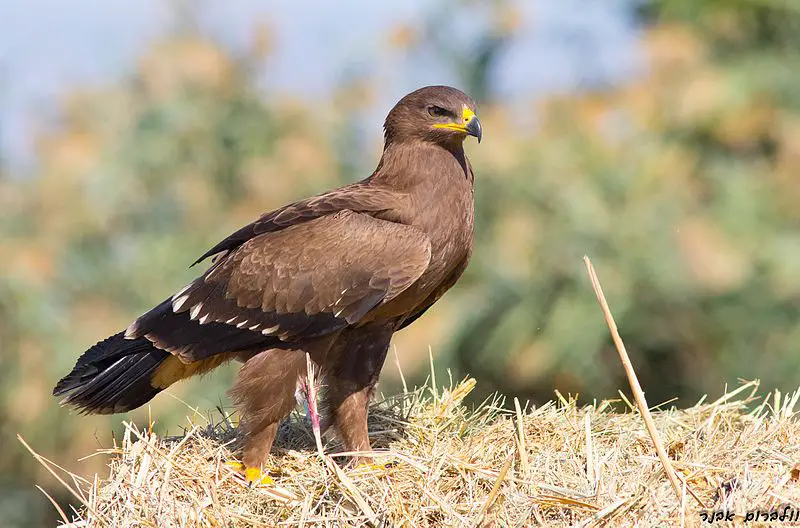
The Lesser Spotted Eagle is a large Eastern European bird of prey that belongs to the Accipitridae family. It has an overall slender body shape, with males averaging around 3kg in weight and females weighing up to 4kg.
Its wingspan can reach up to 180 cm, making it one of the largest birds of prey in Europe. It has a distinctive dark brown upper plumage, pale beige under parts and yellow legs which have black ‘tiger’ stripes running along them.
The head is covered with white feathers while its eyes are yellowish-brown or orangey-red coloured depending on age.
They feed mainly on small mammals such as voles but also takes other smaller animals like reptiles or amphibians if available nearby.
In recent years their population numbers have declined due to habitat loss caused by human activities thus conservation measures for this species must be taken into account so as not only preserve these majestic creatures but also protect our environment at the same timeScientific classification:
| Kingdom | Animalia |
| Phylum | Chordata |
| Class | Aves |
| Order | Accipitriformes |
| Family | Accipitridae |
| Genus | Clanga |
| Species | C. pomarina |
Also Featured In: Birds of Israel,
43. Nightjars
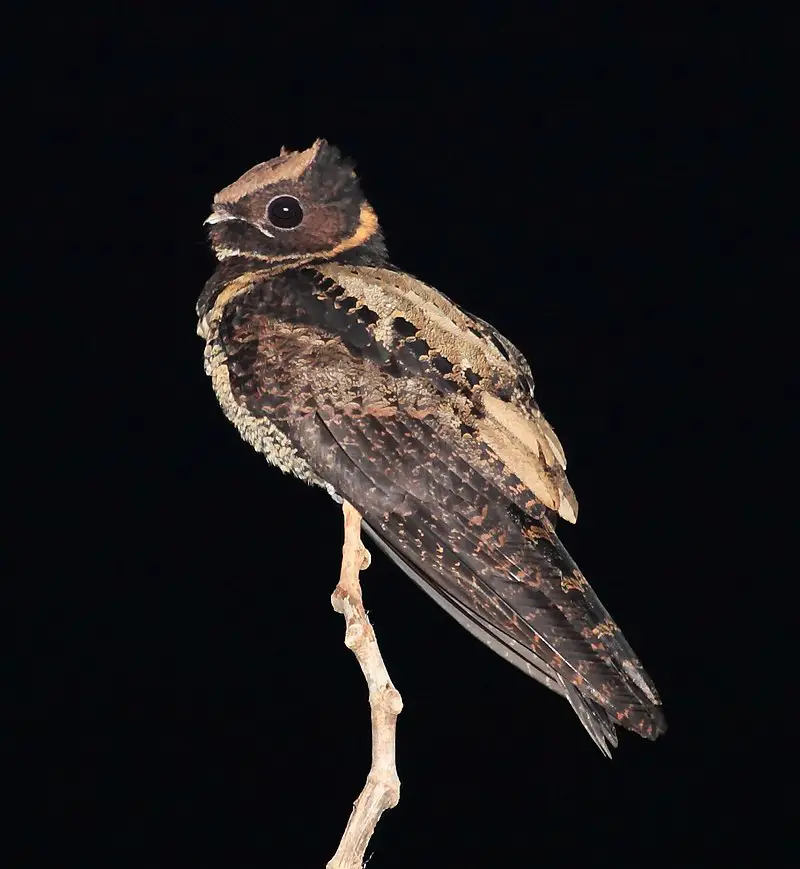
Nightjars are fascinating nocturnal or crepuscular birds belonging to the Caprimulgidae family. These medium-sized birds have long wings, short legs and very small bills.
They can be found across many parts of the world in forests, grasslands and scrubland habitats.
Nightjars feed on insects such as moths, beetles, crickets and cicadas which they catch with their sharp eyesight during night time flights over open fields when hunting for food.
Their scientific name ‘Caprimulgidae’ is derived from an old folktale that claims these birds suck milk from goats.
In reality though, they are harmless creatures who pose no threat to livestock whatsoever.
Nightjars make a variety of different calls ranging from whistles to chirps all throughout the night – adding further mystery to this amazing species.Scientific classification:
| Kingdom | Animalia |
| Phylum | Chordata |
| Class | Aves |
| Clade | Strisores |
| Order | Caprimulgiformes Ridgway, 1881 |
| Family | Caprimulgidae Vigors, 1825 |
Also Featured In: Birds that Live in Guyana, Birds You’ll Find in Night
44. Yelkouan Shearwater
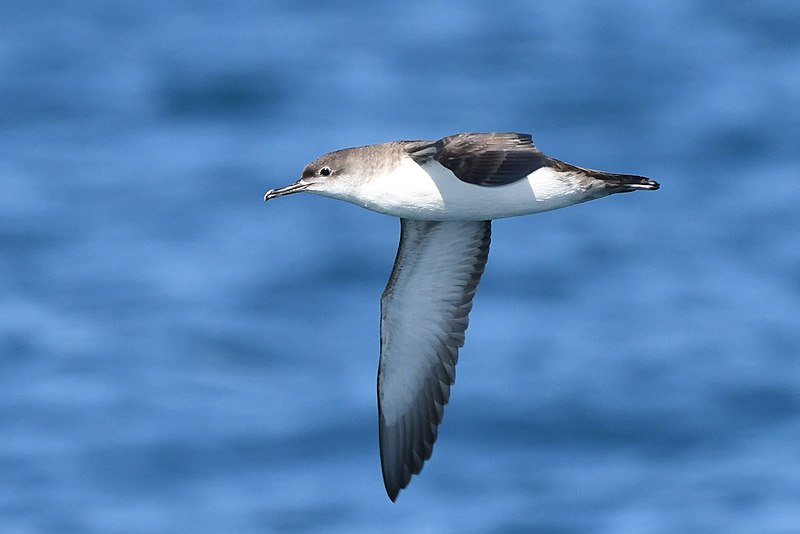
The Yelkouan Shearwater is a medium-sized seabird in the Procellariidae family. It was first described in 1827 by Italian naturalist Giuseppe Acerbi from specimens found near The Bosphorus, Turkey.
This species has also been known as Levantine or Mediterranean shearwater and for some time it was considered to be part of Manx Shearwater (Puffinus puffinus).
They have brownish grey upperparts with white underparts and black legs.
Their wings measure about 35 cm long which helps them during their migrations across the Mediterranean Sea each year between April and October when they leave breeding grounds on islands off south Europe to spend winter months at sea off Africa’s coastlines.
These birds feed mainly on small fish, planktonic crustaceans or squid taken while swimming underwater close to surface but sometimes can take food items directly from water’s surface like most other shearwaters do.Scientific classification:
| Kingdom | Animalia |
| Phylum | Chordata |
| Class | Aves |
| Order | Procellariiformes |
| Family | Procellariidae |
| Genus | Puffinus |
| Species | P. yelkouan |
Also Featured In: Native Birds Of Libya, Most Common Birds of Sardinia
45. Squacco Heron
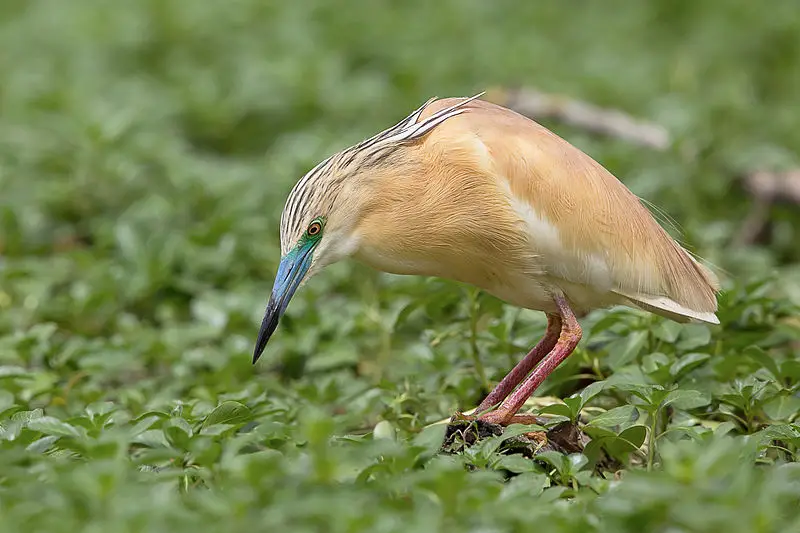
The Squacco Heron is a small heron species native to the Old World that breeds in parts of Europe and the Greater Middle East, before migrating south for winter.
They measure around 44-47 cm long with an 80-92 cm wingspan, making them one of the smaller species of herons.
Their body length measures 20-23cm while they have greyish or brown plumage on top and white or yellow underneath.
The neck has some streaking patterns giving it its name “squacco” which means speckled in Italian. It feeds mainly on fish, frogs and insects near shallow waters such as marshes, swamps and streams.
Rarely sighted north of their breeding grounds this curious little bird should be admired if spotted.Scientific classification:
| Kingdom | Animalia |
| Phylum | Chordata |
| Class | Aves |
| Order | Pelecaniformes |
| Family | Ardeidae |
| Genus | Ardeola |
| Species | A. ralloides |
Also Featured In: Bahrain birds, Naples Islands Birds You Didn’t Know
46. Long-Billed Murrelet
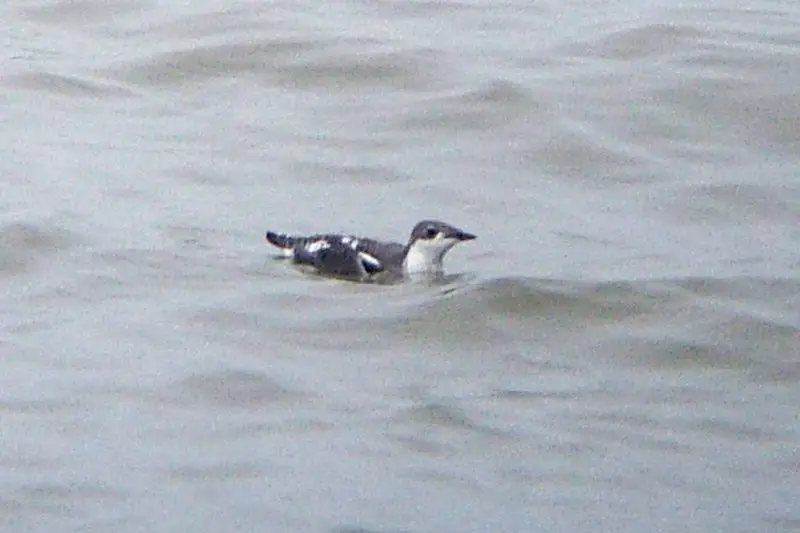
The Long-billed Murrelet is a small seabird that inhabits the North Pacific. Its genus name, Brachyramphus, comes from Ancient Greek and means “short bill”.
The species’ Latin name perdix translates to “partridge”; this was due to its resemblance to the partridge when it was first described by Pallas in 1764 as Magnitudine Perdicis (or “the size of a partridge”).
It is often referred to as simply murrelet, which derives from an unknown source but may imitate their calls. These birds are dark grey on top with white underbellies and have long bills for eating fish at sea.
They breed along coasts of Alaska during summertime before migrating southwards towards California or Japan for the winter months.Scientific classification:
| Kingdom | Animalia |
| Phylum | Chordata |
| Class | Aves |
| Order | Charadriiformes |
| Family | Alcidae |
| Genus | Brachyramphus |
| Species | B. perdix |
Also Featured In: Auks Species,
47. Rough-Legged Buzzard
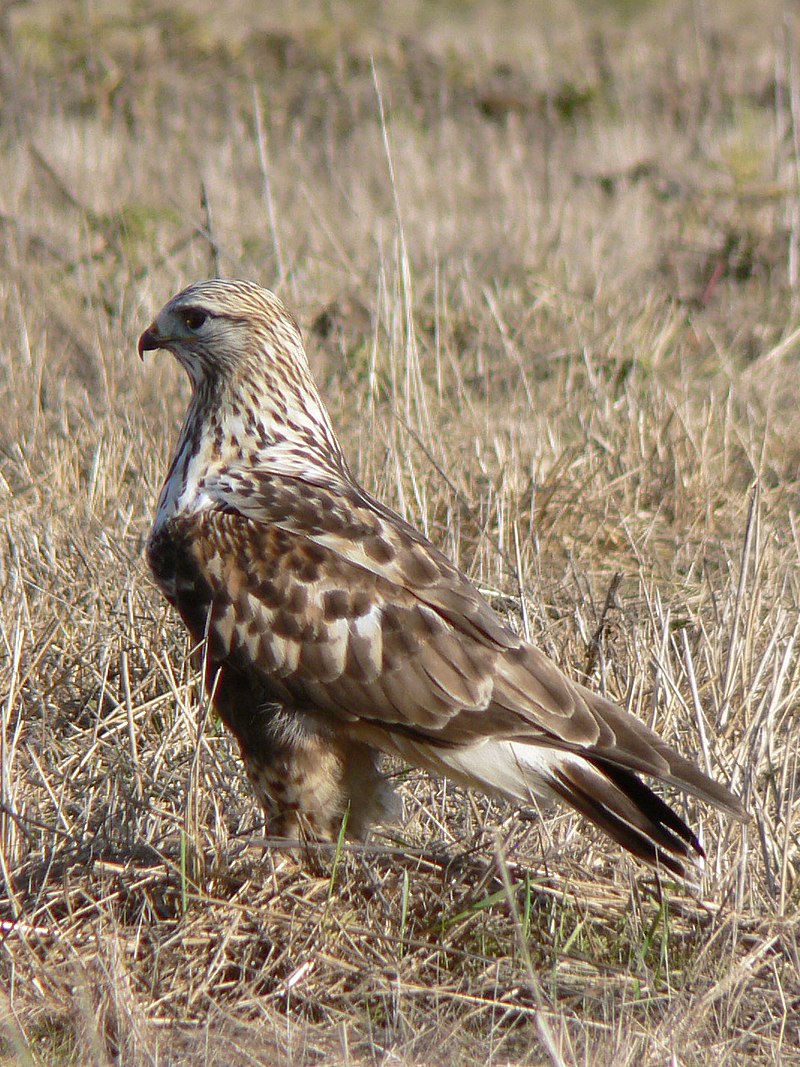
The Rough-legged Buzzard, also known as the Rough-legged Hawk, is a medium to large bird of prey that inhabits Arctic and Subarctic regions in North America, Europe and Russia.
It migrates south during winter. These majestic birds build their nests on cliffs or other rocky ledges making them difficult to spot from afar.
Their plumage can be either dark brown or light with barred underparts and a white head – depending on seasonality.
They have long wings which helps them cover incredible distances while migrating but they are by no means fast flyers – preferring instead soaring flight patterns where possible.
The primary diet for these raptors consists of small rodents such as voles and lemmings however they will take larger prey if needed (such as grouse).Scientific classification:
| Kingdom | Animalia |
| Phylum | Chordata |
| Class | Aves |
| Order | Accipitriformes |
| Family | Accipitridae |
| Genus | Buteo |
| Species | B. lagopus |
Also Featured In: birds of Massachusetts, Birds of Norfolk
48. Ring-Necked Pheasant
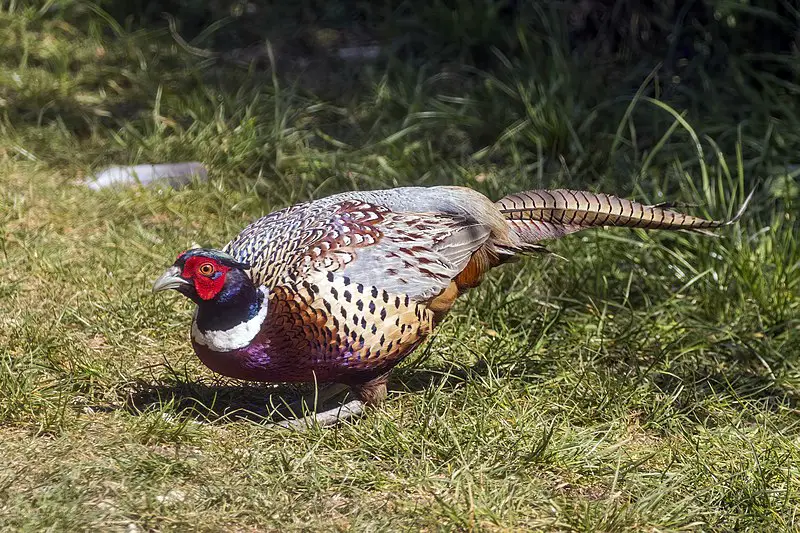
The Ring-necked Pheasant (Phasianus colchicus) is a stunning bird from the pheasant family. It has an iridescent green and gold plumage, with bright red facial wattles and white neck rings that contrast against its black tail feathers.
This elegant species can be found in fields, meadows, woodlands and open areas across Northern Europe to East Asia where it feeds on grain, insects and other small animals. The male displays spectacular courtship rituals to attract mates.
He spreads his wings wide while making loud calls as a sign of dominance which helps him establish territories for breeding season.
Despite being hunted for both food by humans or predators like foxes and cats this magnificent creature remains one of nature’s most beautiful sights.Scientific classification:
| Kingdom | Animalia |
| Phylum | Chordata |
| Class | Aves |
| Order | Galliformes |
| Family | Phasianidae |
| Genus | Phasianus |
| Species | P. colchicus |
Also Featured In: birds of South Dakota, Asian Birds
49. European Robin
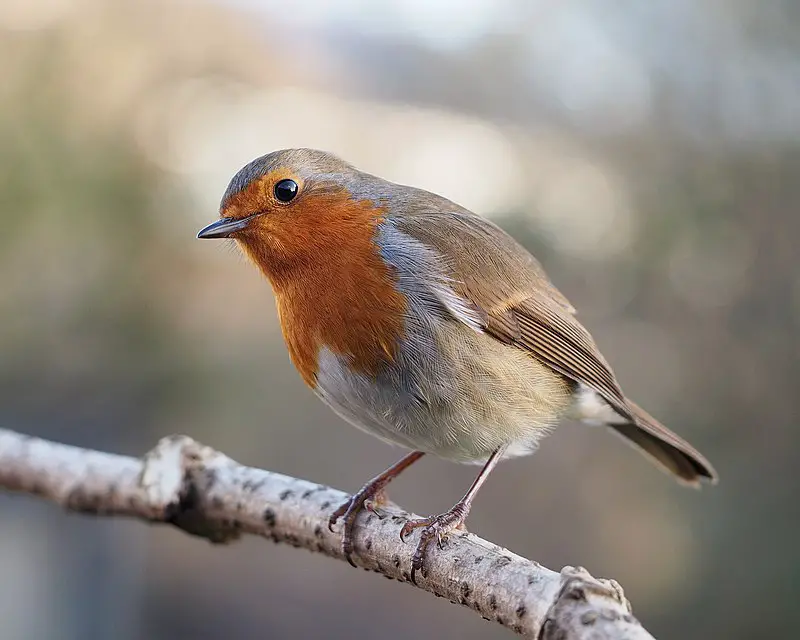
The European robin, also known as simply robin or robin redbreast, is a small insect-eating bird belonging to the chat subfamily.
This bird species can be found across Europe, extending east to Western Siberia while inhabiting North Africa.
The bird species is relatively sedentary and is found in most of its range, except for the far north.
Measuring around 12.5-14.0 cm, this bird is commonly known for its distinctively red breast feathers.
As an insectivorous passerine bird, the European robin mainly feeds on insects to sustain its energy.
Given its widespread range throughout Europe and continuous presence in certain parts of the world, the European robin is widely recognized for its distinct physical appearance, singsong voice, and tiny size.Scientific classification:
| Kingdom | Animalia |
| Phylum | Chordata |
| Class | Aves |
| Order | Passeriformes |
| Family | Muscicapidae |
| Genus | Erithacus |
| Species | E. rubecula |
Also Featured In: Most Common Songs Birds that Live around You, Italian Birds You Should Know
50. European Nightjar
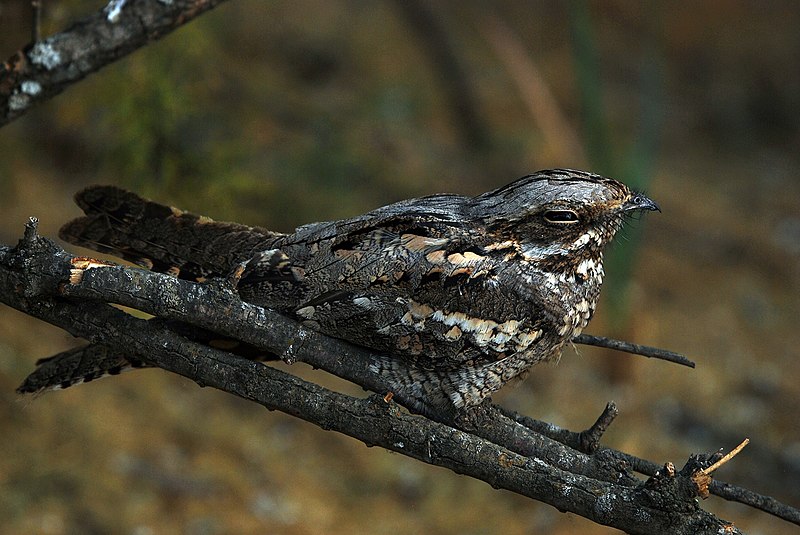
The European nightjar is a nocturnal bird that can be found in Europe, the Palearctic region, Mongolia, and Northwestern China.
It belongs to the nightjar family and is known by several names, including the common goatsucker and Eurasian nightjar.
There are six subspecies of this bird. The nightjar is crepuscular, meaning it is most active during dawn and dusk.
Its Latin generic name comes from an old myth that the bird suckled from goats, causing them to stop giving milk.
The European nightjar is well-adapted to its nocturnal lifestyle with large eyes and wide gape that help it catch flying insects in the dark.
Its plumage is cryptic, blending in with its surroundings, making it difficult to spot. The bird usually nests on the ground, and the male performs aerial displays during breeding season.Scientific classification:
| Kingdom | Animalia |
| Phylum | Chordata |
| Class | Aves |
| Clade | Strisores |
| Order | Caprimulgiformes |
| Family | Caprimulgidae |
| Genus | Caprimulgus |
| Species | C. europaeus |
Also Featured In: Turkey Birds You Should Know, Ukrainian Birds You Should Know
51. Flamingos
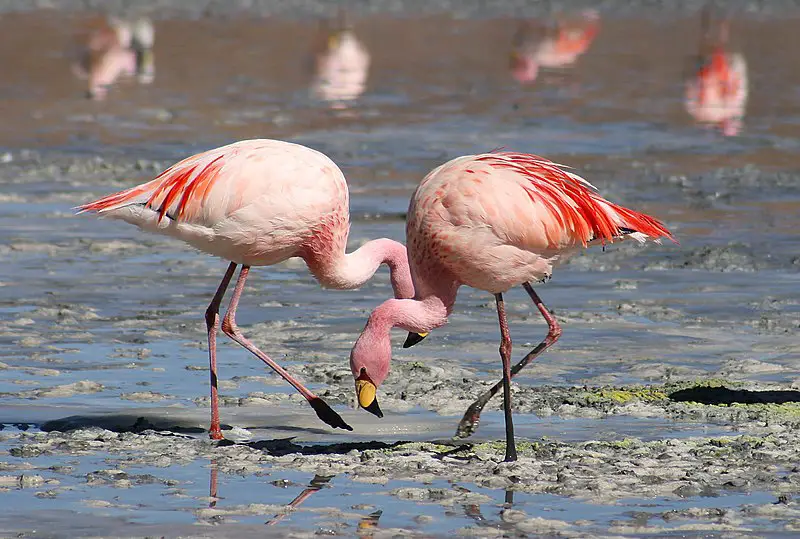
Flamingos are a type of water bird that belong to the Phoenicopteriformes group. They are known for their distinctive pink coloring and long, thin legs.
Flamingos are closely related to grebes and are part of the Mirandornithes clade. These birds are well-documented in the fossil record, with some of their extinct relatives dating back millions of years.
In fact, the first known member of the Phoenicopteridae family was a bird called Elornis. Flamingos are known for their unique feeding habits, which involve using their beaks to filter food from the water.
They are also social creatures that typically live in large groups called colonies.
Overall, flamingos are fascinating creatures with a long history on our planet.Scientific classification:
| Kingdom | Animalia |
| Phylum | Chordata |
| Class | Aves |
| Clade | Mirandornithes |
| Order | Phoenicopteriformes Fürbringer, 1888 |
Also Featured In: Common Algerian Birds , Syrian Birds You Need to Know